Cultural Competitiveness and Profitable Investment in Tourism Industry
VerifiedAdded on 2019/09/26
|27
|5525
|615
Report
AI Summary
The content discusses the importance of corruption in the tourism industry, particularly in developing countries like Sri Lanka. Corruption can negatively impact the tourism sector by increasing costs, affecting local communities and eroding the country's image. It is crucial for governments to address corruption and implement strategies to promote a positive destination image, increase visitor expenditure, and protect existing market share.
Contribute Materials
Your contribution can guide someone’s learning journey. Share your
documents today.
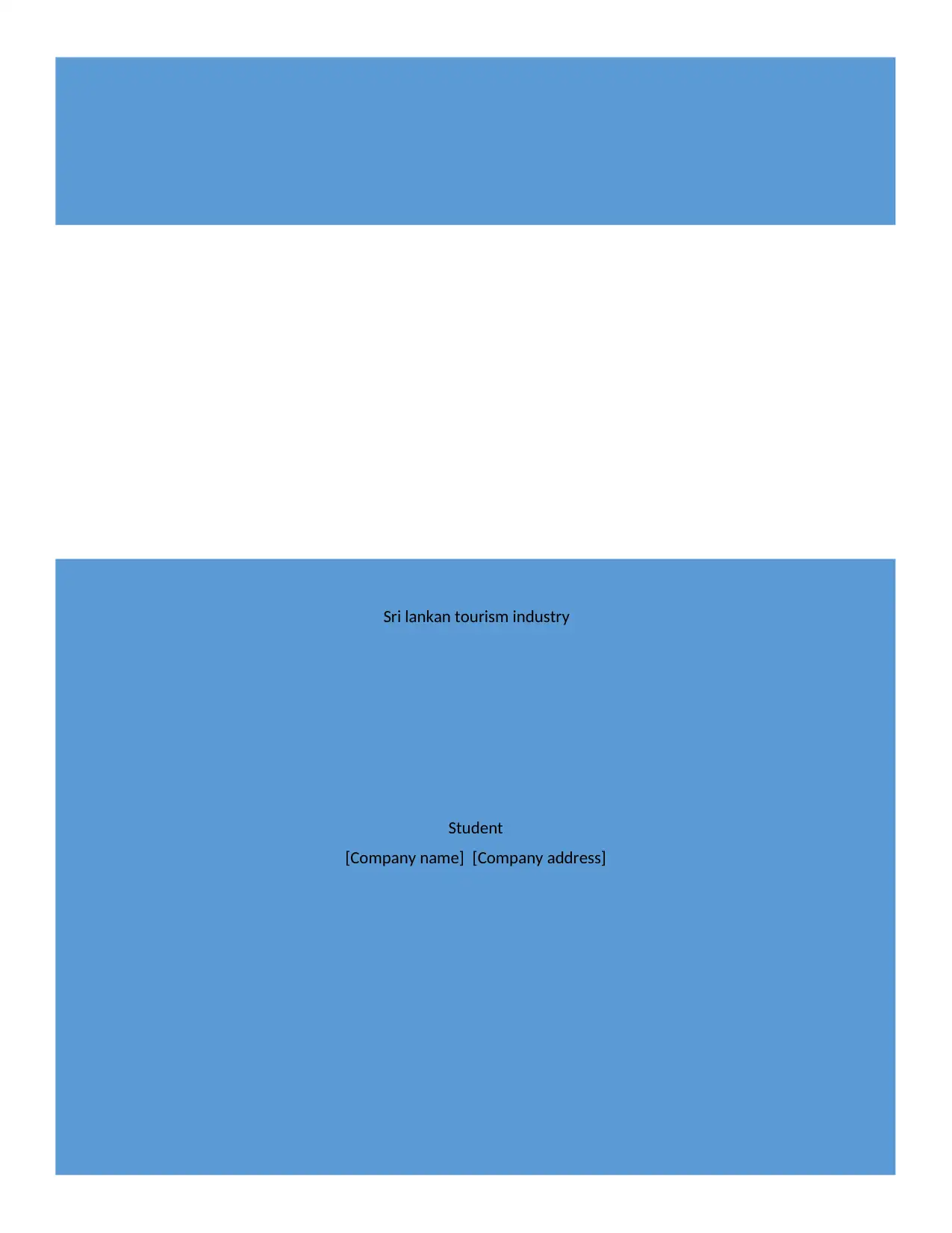
Sri lankan tourism industry
Student
[Company name] [Company address]
Student
[Company name] [Company address]
Secure Best Marks with AI Grader
Need help grading? Try our AI Grader for instant feedback on your assignments.
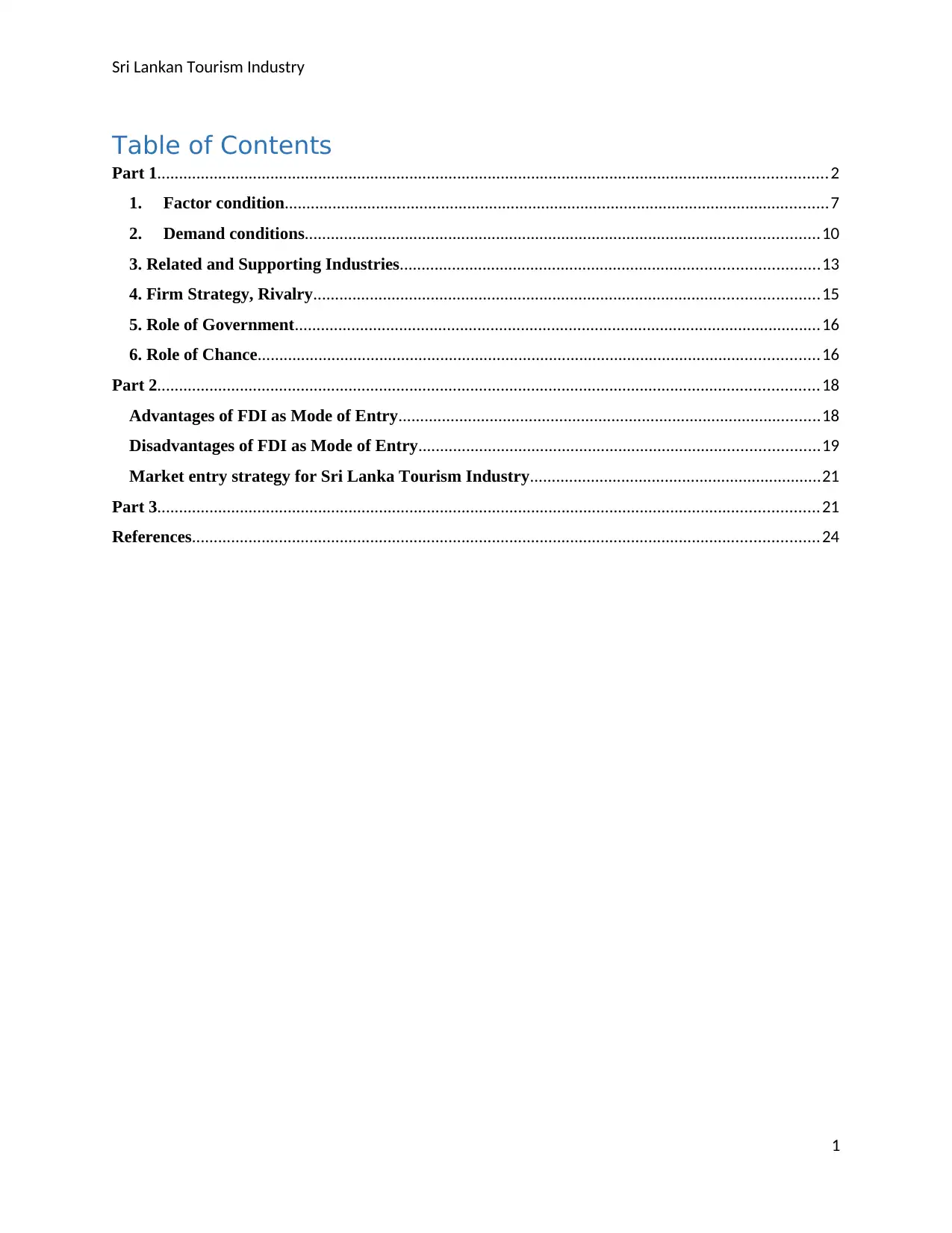
Sri Lankan Tourism Industry
Table of Contents
Part 1..........................................................................................................................................................2
1. Factor condition.............................................................................................................................7
2. Demand conditions......................................................................................................................10
3. Related and Supporting Industries................................................................................................13
4. Firm Strategy, Rivalry....................................................................................................................15
5. Role of Government.........................................................................................................................16
6. Role of Chance.................................................................................................................................16
Part 2........................................................................................................................................................18
Advantages of FDI as Mode of Entry.................................................................................................18
Disadvantages of FDI as Mode of Entry............................................................................................19
Market entry strategy for Sri Lanka Tourism Industry...................................................................21
Part 3........................................................................................................................................................21
References................................................................................................................................................24
1
Table of Contents
Part 1..........................................................................................................................................................2
1. Factor condition.............................................................................................................................7
2. Demand conditions......................................................................................................................10
3. Related and Supporting Industries................................................................................................13
4. Firm Strategy, Rivalry....................................................................................................................15
5. Role of Government.........................................................................................................................16
6. Role of Chance.................................................................................................................................16
Part 2........................................................................................................................................................18
Advantages of FDI as Mode of Entry.................................................................................................18
Disadvantages of FDI as Mode of Entry............................................................................................19
Market entry strategy for Sri Lanka Tourism Industry...................................................................21
Part 3........................................................................................................................................................21
References................................................................................................................................................24
1
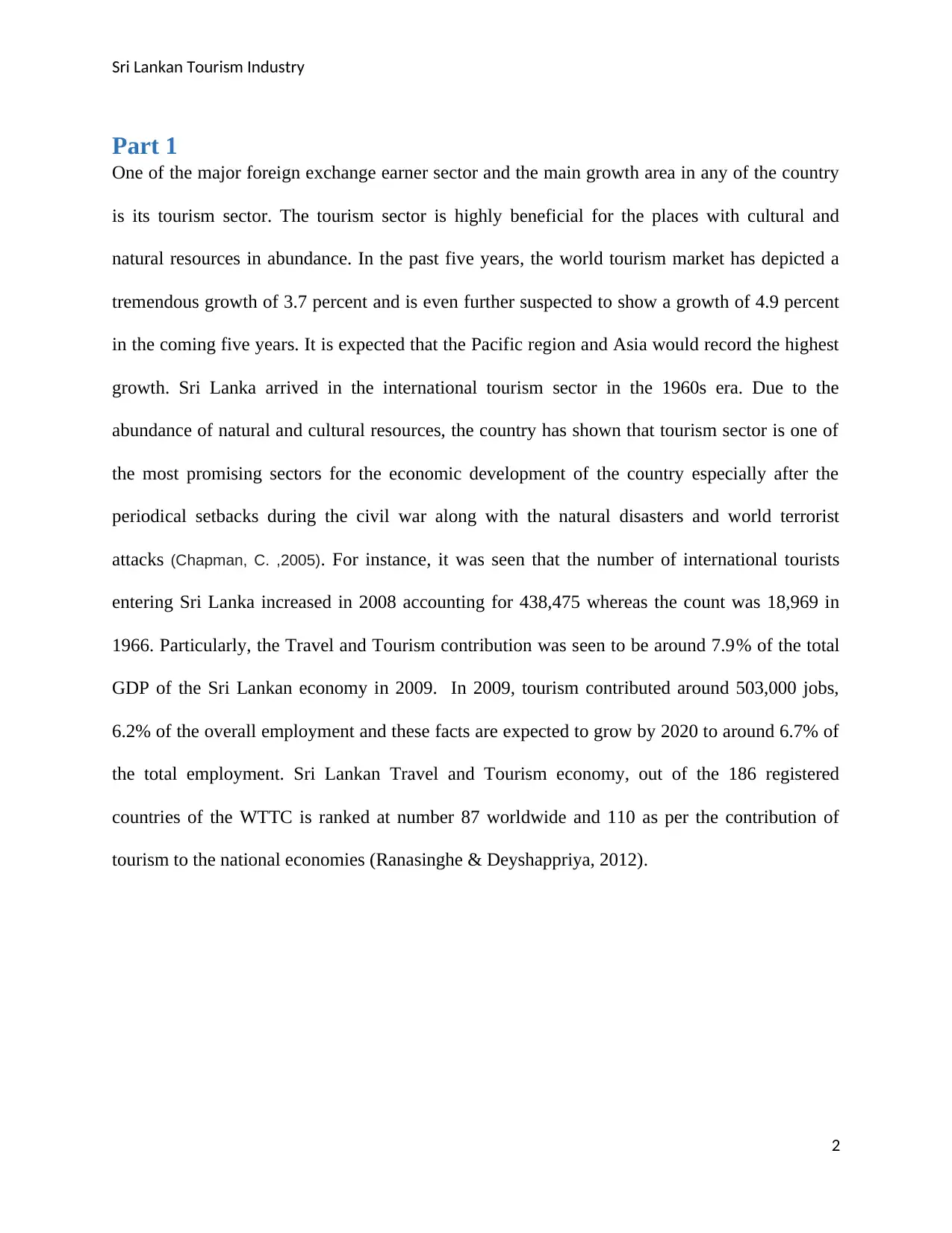
Sri Lankan Tourism Industry
Part 1
One of the major foreign exchange earner sector and the main growth area in any of the country
is its tourism sector. The tourism sector is highly beneficial for the places with cultural and
natural resources in abundance. In the past five years, the world tourism market has depicted a
tremendous growth of 3.7 percent and is even further suspected to show a growth of 4.9 percent
in the coming five years. It is expected that the Pacific region and Asia would record the highest
growth. Sri Lanka arrived in the international tourism sector in the 1960s era. Due to the
abundance of natural and cultural resources, the country has shown that tourism sector is one of
the most promising sectors for the economic development of the country especially after the
periodical setbacks during the civil war along with the natural disasters and world terrorist
attacks (Chapman, C. ,2005). For instance, it was seen that the number of international tourists
entering Sri Lanka increased in 2008 accounting for 438,475 whereas the count was 18,969 in
1966. Particularly, the Travel and Tourism contribution was seen to be around 7.9% of the total
GDP of the Sri Lankan economy in 2009. In 2009, tourism contributed around 503,000 jobs,
6.2% of the overall employment and these facts are expected to grow by 2020 to around 6.7% of
the total employment. Sri Lankan Travel and Tourism economy, out of the 186 registered
countries of the WTTC is ranked at number 87 worldwide and 110 as per the contribution of
tourism to the national economies (Ranasinghe & Deyshappriya, 2012).
2
Part 1
One of the major foreign exchange earner sector and the main growth area in any of the country
is its tourism sector. The tourism sector is highly beneficial for the places with cultural and
natural resources in abundance. In the past five years, the world tourism market has depicted a
tremendous growth of 3.7 percent and is even further suspected to show a growth of 4.9 percent
in the coming five years. It is expected that the Pacific region and Asia would record the highest
growth. Sri Lanka arrived in the international tourism sector in the 1960s era. Due to the
abundance of natural and cultural resources, the country has shown that tourism sector is one of
the most promising sectors for the economic development of the country especially after the
periodical setbacks during the civil war along with the natural disasters and world terrorist
attacks (Chapman, C. ,2005). For instance, it was seen that the number of international tourists
entering Sri Lanka increased in 2008 accounting for 438,475 whereas the count was 18,969 in
1966. Particularly, the Travel and Tourism contribution was seen to be around 7.9% of the total
GDP of the Sri Lankan economy in 2009. In 2009, tourism contributed around 503,000 jobs,
6.2% of the overall employment and these facts are expected to grow by 2020 to around 6.7% of
the total employment. Sri Lankan Travel and Tourism economy, out of the 186 registered
countries of the WTTC is ranked at number 87 worldwide and 110 as per the contribution of
tourism to the national economies (Ranasinghe & Deyshappriya, 2012).
2
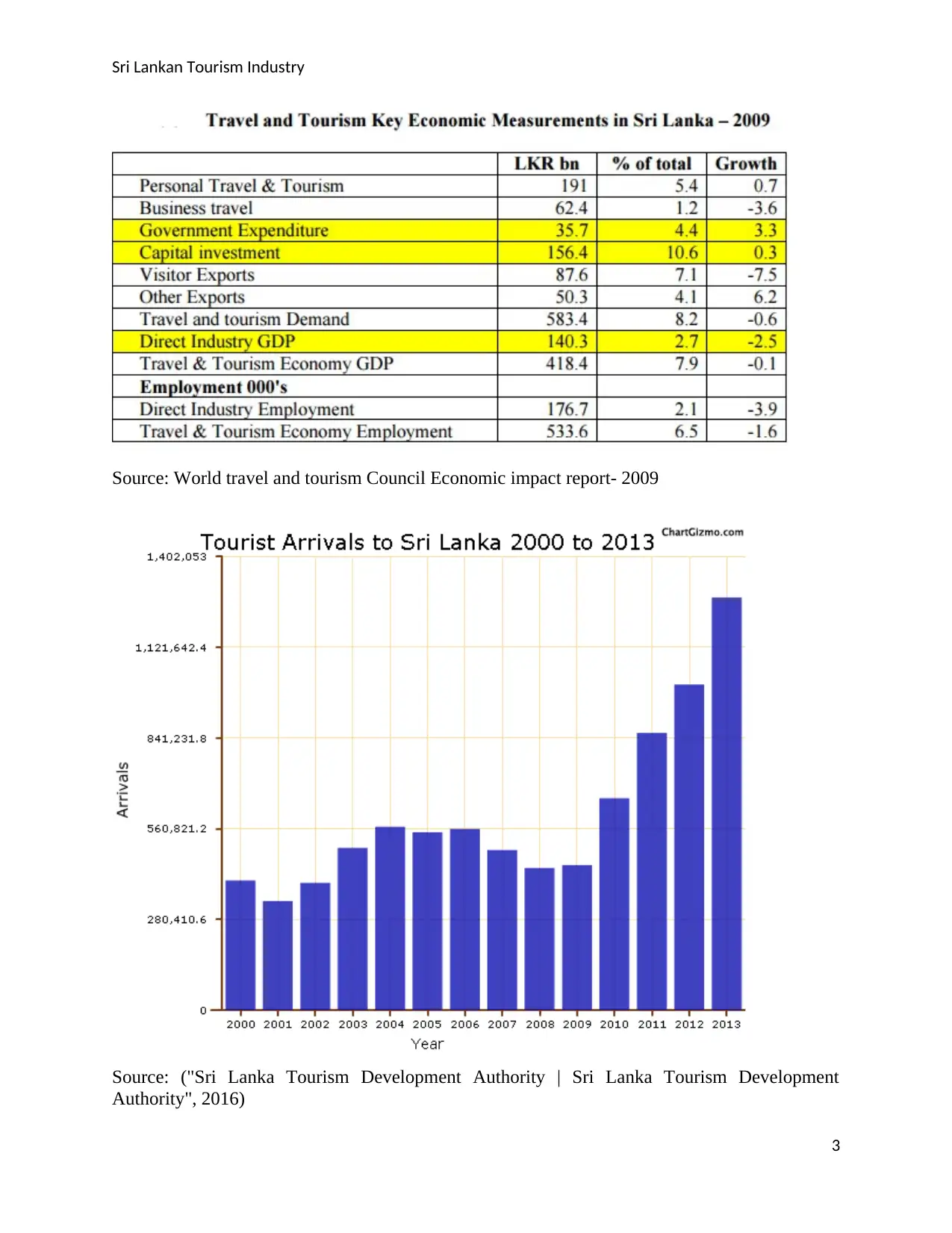
Sri Lankan Tourism Industry
Source: World travel and tourism Council Economic impact report- 2009
Source: ("Sri Lanka Tourism Development Authority | Sri Lanka Tourism Development
Authority", 2016)
3
Source: World travel and tourism Council Economic impact report- 2009
Source: ("Sri Lanka Tourism Development Authority | Sri Lanka Tourism Development
Authority", 2016)
3
Paraphrase This Document
Need a fresh take? Get an instant paraphrase of this document with our AI Paraphraser

Sri Lankan Tourism Industry
The strategic issue in the field of the tourism industry of Sri Lanka is considered to be the
competitiveness. In contrast to the other regions in Asia and the world, the last five years of the
tourism growth in Sri Lanka are found to be highly flat. The tourism sector has realized that lack
of growth in due to the civil conflict in the nation and the sector has also recognized the other
serious constraints related to the tourism business and its operations in the way the business is
proceeding. This can be evaluated using the Porter’s model of the competitive advantage or the
Porter’s Diamond.
Porter’s model of the competitive advantage which is also known as the Porter’s Diamond is
used as a powerful methodology which can help to establish enterprise for achieving superior
competitiveness in this whole while the world of globalized economy. This model does not
define the competitiveness of the enterprise present in a nation on the basis of the natural as well
as favorable factors nut also depends on the factors that are generated by negative and positive
synergies having an ultimate goal towards the productivity growth. The Porter’s model or the
‘Diamond of National Competitive Advantage’ has presented four major elements of the nation
that will help in shaping up of the local firms to compete so as to hamper or may be support the
competitive advantage namely: factor conditions, demand conditions, related and supporting
industries and the firm strategy and rivalry. Additionally, the role of government and the role of
chance should also be taken into account for assessing the competitive advantage of the nation
(Porter, M. (1998). The competitive advantage of nations. New York: Free Press)
4
The strategic issue in the field of the tourism industry of Sri Lanka is considered to be the
competitiveness. In contrast to the other regions in Asia and the world, the last five years of the
tourism growth in Sri Lanka are found to be highly flat. The tourism sector has realized that lack
of growth in due to the civil conflict in the nation and the sector has also recognized the other
serious constraints related to the tourism business and its operations in the way the business is
proceeding. This can be evaluated using the Porter’s model of the competitive advantage or the
Porter’s Diamond.
Porter’s model of the competitive advantage which is also known as the Porter’s Diamond is
used as a powerful methodology which can help to establish enterprise for achieving superior
competitiveness in this whole while the world of globalized economy. This model does not
define the competitiveness of the enterprise present in a nation on the basis of the natural as well
as favorable factors nut also depends on the factors that are generated by negative and positive
synergies having an ultimate goal towards the productivity growth. The Porter’s model or the
‘Diamond of National Competitive Advantage’ has presented four major elements of the nation
that will help in shaping up of the local firms to compete so as to hamper or may be support the
competitive advantage namely: factor conditions, demand conditions, related and supporting
industries and the firm strategy and rivalry. Additionally, the role of government and the role of
chance should also be taken into account for assessing the competitive advantage of the nation
(Porter, M. (1998). The competitive advantage of nations. New York: Free Press)
4
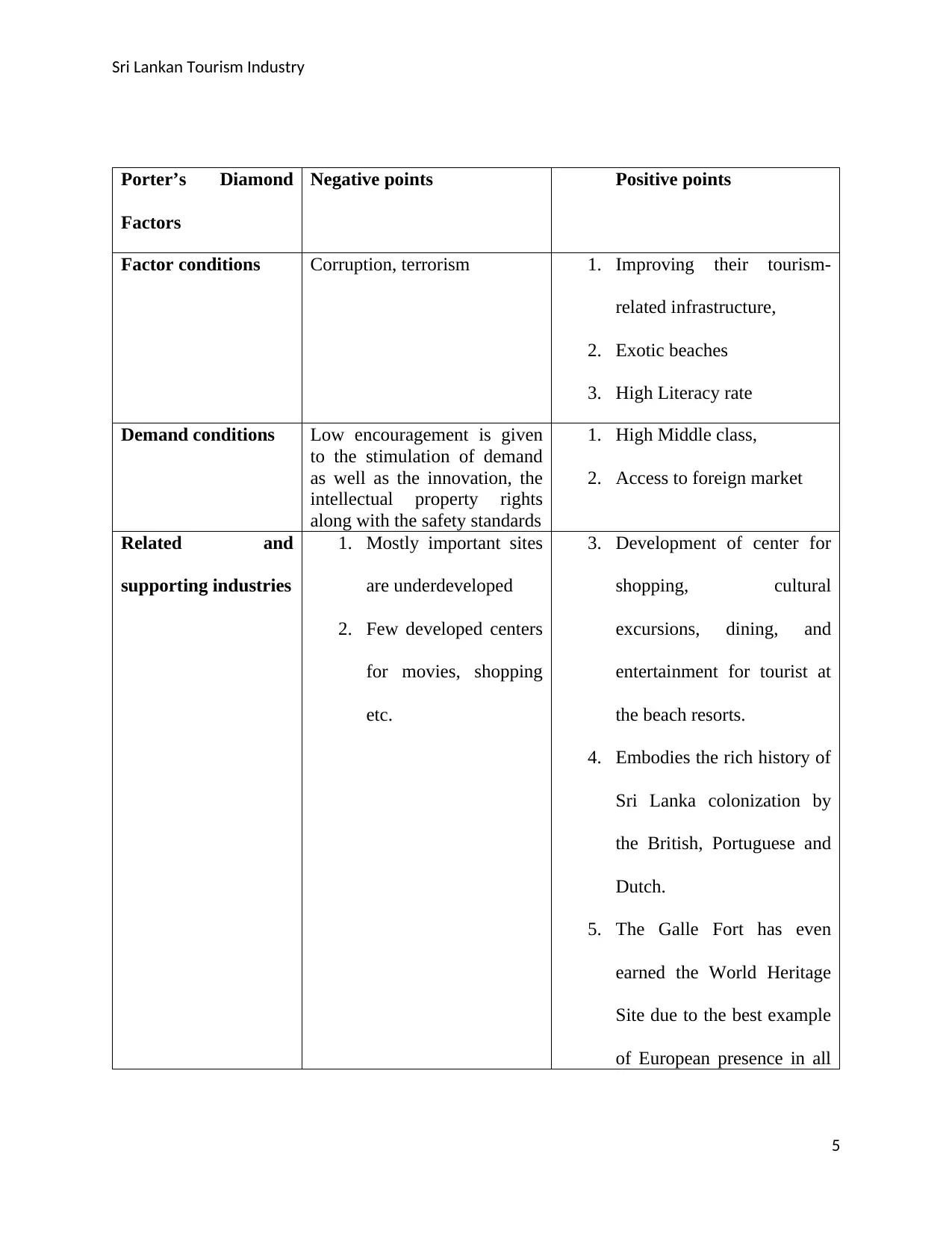
Sri Lankan Tourism Industry
Porter’s Diamond
Factors
Negative points Positive points
Factor conditions Corruption, terrorism 1. Improving their tourism-
related infrastructure,
2. Exotic beaches
3. High Literacy rate
Demand conditions Low encouragement is given
to the stimulation of demand
as well as the innovation, the
intellectual property rights
along with the safety standards
1. High Middle class,
2. Access to foreign market
Related and
supporting industries
1. Mostly important sites
are underdeveloped
2. Few developed centers
for movies, shopping
etc.
3. Development of center for
shopping, cultural
excursions, dining, and
entertainment for tourist at
the beach resorts.
4. Embodies the rich history of
Sri Lanka colonization by
the British, Portuguese and
Dutch.
5. The Galle Fort has even
earned the World Heritage
Site due to the best example
of European presence in all
5
Porter’s Diamond
Factors
Negative points Positive points
Factor conditions Corruption, terrorism 1. Improving their tourism-
related infrastructure,
2. Exotic beaches
3. High Literacy rate
Demand conditions Low encouragement is given
to the stimulation of demand
as well as the innovation, the
intellectual property rights
along with the safety standards
1. High Middle class,
2. Access to foreign market
Related and
supporting industries
1. Mostly important sites
are underdeveloped
2. Few developed centers
for movies, shopping
etc.
3. Development of center for
shopping, cultural
excursions, dining, and
entertainment for tourist at
the beach resorts.
4. Embodies the rich history of
Sri Lanka colonization by
the British, Portuguese and
Dutch.
5. The Galle Fort has even
earned the World Heritage
Site due to the best example
of European presence in all
5
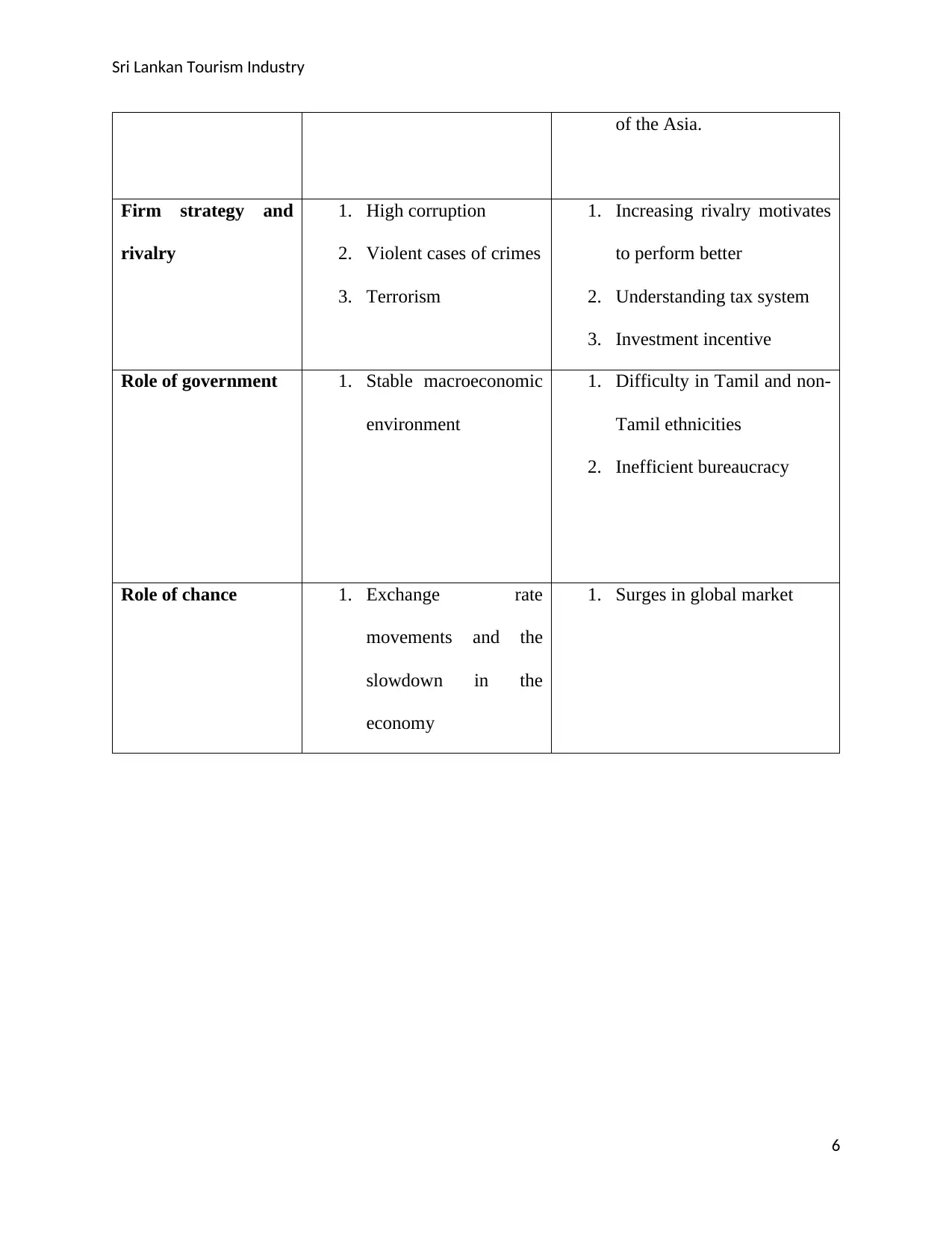
Sri Lankan Tourism Industry
of the Asia.
Firm strategy and
rivalry
1. High corruption
2. Violent cases of crimes
3. Terrorism
1. Increasing rivalry motivates
to perform better
2. Understanding tax system
3. Investment incentive
Role of government 1. Stable macroeconomic
environment
1. Difficulty in Tamil and non-
Tamil ethnicities
2. Inefficient bureaucracy
Role of chance 1. Exchange rate
movements and the
slowdown in the
economy
1. Surges in global market
6
of the Asia.
Firm strategy and
rivalry
1. High corruption
2. Violent cases of crimes
3. Terrorism
1. Increasing rivalry motivates
to perform better
2. Understanding tax system
3. Investment incentive
Role of government 1. Stable macroeconomic
environment
1. Difficulty in Tamil and non-
Tamil ethnicities
2. Inefficient bureaucracy
Role of chance 1. Exchange rate
movements and the
slowdown in the
economy
1. Surges in global market
6
Secure Best Marks with AI Grader
Need help grading? Try our AI Grader for instant feedback on your assignments.
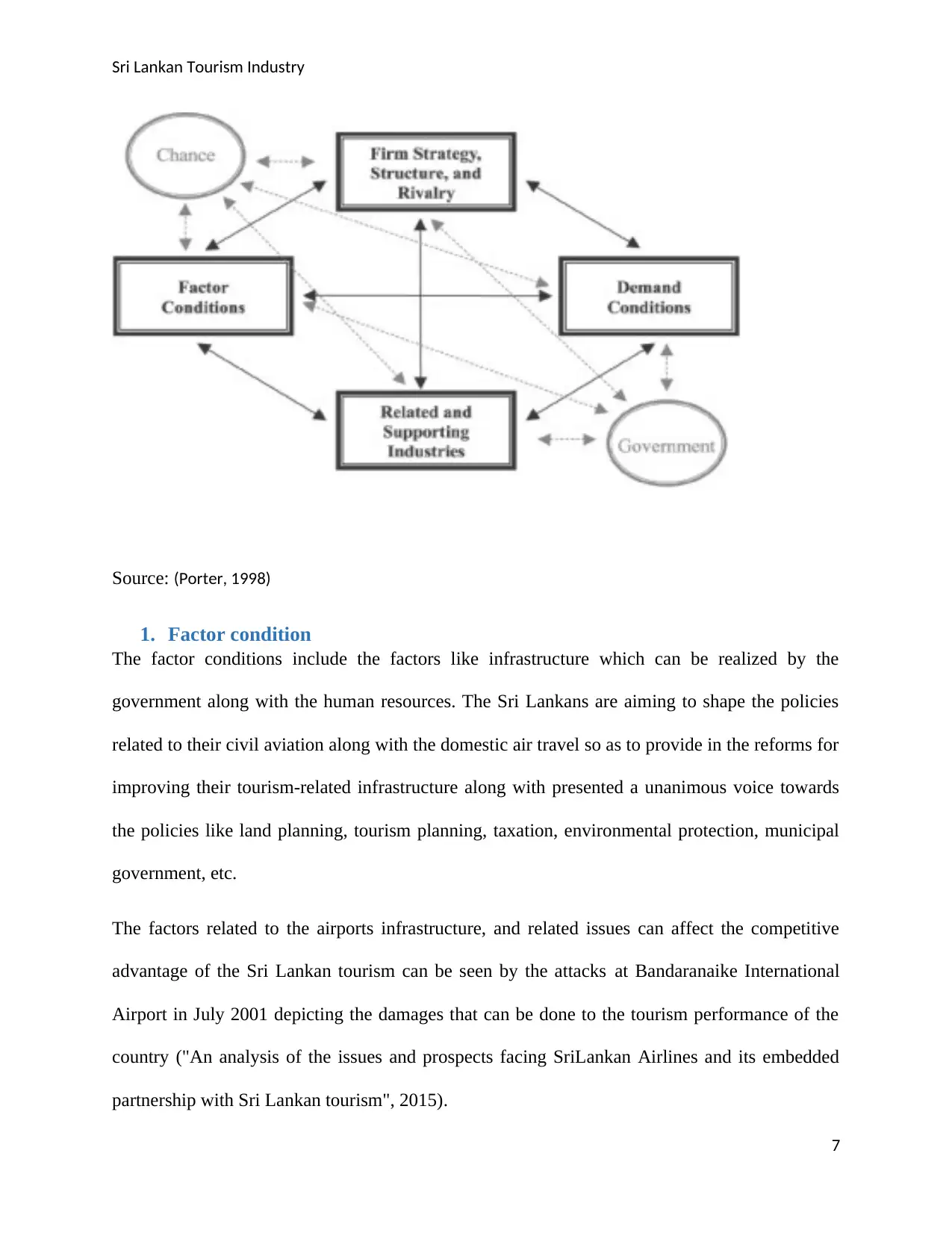
Sri Lankan Tourism Industry
Source: (Porter, 1998)
1. Factor condition
The factor conditions include the factors like infrastructure which can be realized by the
government along with the human resources. The Sri Lankans are aiming to shape the policies
related to their civil aviation along with the domestic air travel so as to provide in the reforms for
improving their tourism-related infrastructure along with presented a unanimous voice towards
the policies like land planning, tourism planning, taxation, environmental protection, municipal
government, etc.
The factors related to the airports infrastructure, and related issues can affect the competitive
advantage of the Sri Lankan tourism can be seen by the attacks at Bandaranaike International
Airport in July 2001 depicting the damages that can be done to the tourism performance of the
country ("An analysis of the issues and prospects facing SriLankan Airlines and its embedded
partnership with Sri Lankan tourism", 2015).
7
Source: (Porter, 1998)
1. Factor condition
The factor conditions include the factors like infrastructure which can be realized by the
government along with the human resources. The Sri Lankans are aiming to shape the policies
related to their civil aviation along with the domestic air travel so as to provide in the reforms for
improving their tourism-related infrastructure along with presented a unanimous voice towards
the policies like land planning, tourism planning, taxation, environmental protection, municipal
government, etc.
The factors related to the airports infrastructure, and related issues can affect the competitive
advantage of the Sri Lankan tourism can be seen by the attacks at Bandaranaike International
Airport in July 2001 depicting the damages that can be done to the tourism performance of the
country ("An analysis of the issues and prospects facing SriLankan Airlines and its embedded
partnership with Sri Lankan tourism", 2015).
7

Sri Lankan Tourism Industry
The natural and cultural resources of Sri Lanka like the exotic beaches provide a competitive
edge to the tourism industry of the country. This is one of the key variables of the country's
tourism industry. Furthermore, the factor conditions of the Sri Lankan tourism industry include:
The welcoming nature of the people, a strategic location that is highly accessible for the markets
that are considered to be tourist-generating markets of Asia and western Europe, serene
environment ranging from beaches to rainforest and finally to the mountains, diverse and highly
unique flora and fauna, multicultural heritage of the foods, customs, and arts, high literacy rate
with high English literacy and amusing history with seven ancient world heritage sites with
highly varied colonial connections. ("Sri Lanka Tourism - The Official Website of Sri Lanka
Tourism", 2016)
The external markets of the Sri Lankan tourism industry are spread across the major regions like
Western Europe and Asia. The ideological commitment of Sri Lanka towards liberalization as
well as the open economy which will be a major impact to the dynamics of the industry over the
long run. (H.M.T.S, H. & A., R, 2011).
The location is a very critical issue in this aspect. The Sri Lankan tourism industry faces strong
competition from the countries like Indonesia, India, Maldives, Thailand, Malaysia, etc. An
annual increase in the international tourism has been to be 8 percent to 3 percent. Furthermore,
an important need for highly educated and skilled workforce for the industry is an identified
concern.
The Sri Lankan Tourism Board in 2010 has hired almost 38,000 as well as indirect employment
of around 53,000. Furthermore, it has been estimated by WTTC that around 217,000 jobs as well
as indirect 330,000 jobs whose combination represents around 7 percent of total employment of
Sri Lanka (A Competitiveness Strategy for Sri Lanka’s Tourism Industry, 2002)
8
The natural and cultural resources of Sri Lanka like the exotic beaches provide a competitive
edge to the tourism industry of the country. This is one of the key variables of the country's
tourism industry. Furthermore, the factor conditions of the Sri Lankan tourism industry include:
The welcoming nature of the people, a strategic location that is highly accessible for the markets
that are considered to be tourist-generating markets of Asia and western Europe, serene
environment ranging from beaches to rainforest and finally to the mountains, diverse and highly
unique flora and fauna, multicultural heritage of the foods, customs, and arts, high literacy rate
with high English literacy and amusing history with seven ancient world heritage sites with
highly varied colonial connections. ("Sri Lanka Tourism - The Official Website of Sri Lanka
Tourism", 2016)
The external markets of the Sri Lankan tourism industry are spread across the major regions like
Western Europe and Asia. The ideological commitment of Sri Lanka towards liberalization as
well as the open economy which will be a major impact to the dynamics of the industry over the
long run. (H.M.T.S, H. & A., R, 2011).
The location is a very critical issue in this aspect. The Sri Lankan tourism industry faces strong
competition from the countries like Indonesia, India, Maldives, Thailand, Malaysia, etc. An
annual increase in the international tourism has been to be 8 percent to 3 percent. Furthermore,
an important need for highly educated and skilled workforce for the industry is an identified
concern.
The Sri Lankan Tourism Board in 2010 has hired almost 38,000 as well as indirect employment
of around 53,000. Furthermore, it has been estimated by WTTC that around 217,000 jobs as well
as indirect 330,000 jobs whose combination represents around 7 percent of total employment of
Sri Lanka (A Competitiveness Strategy for Sri Lanka’s Tourism Industry, 2002)
8
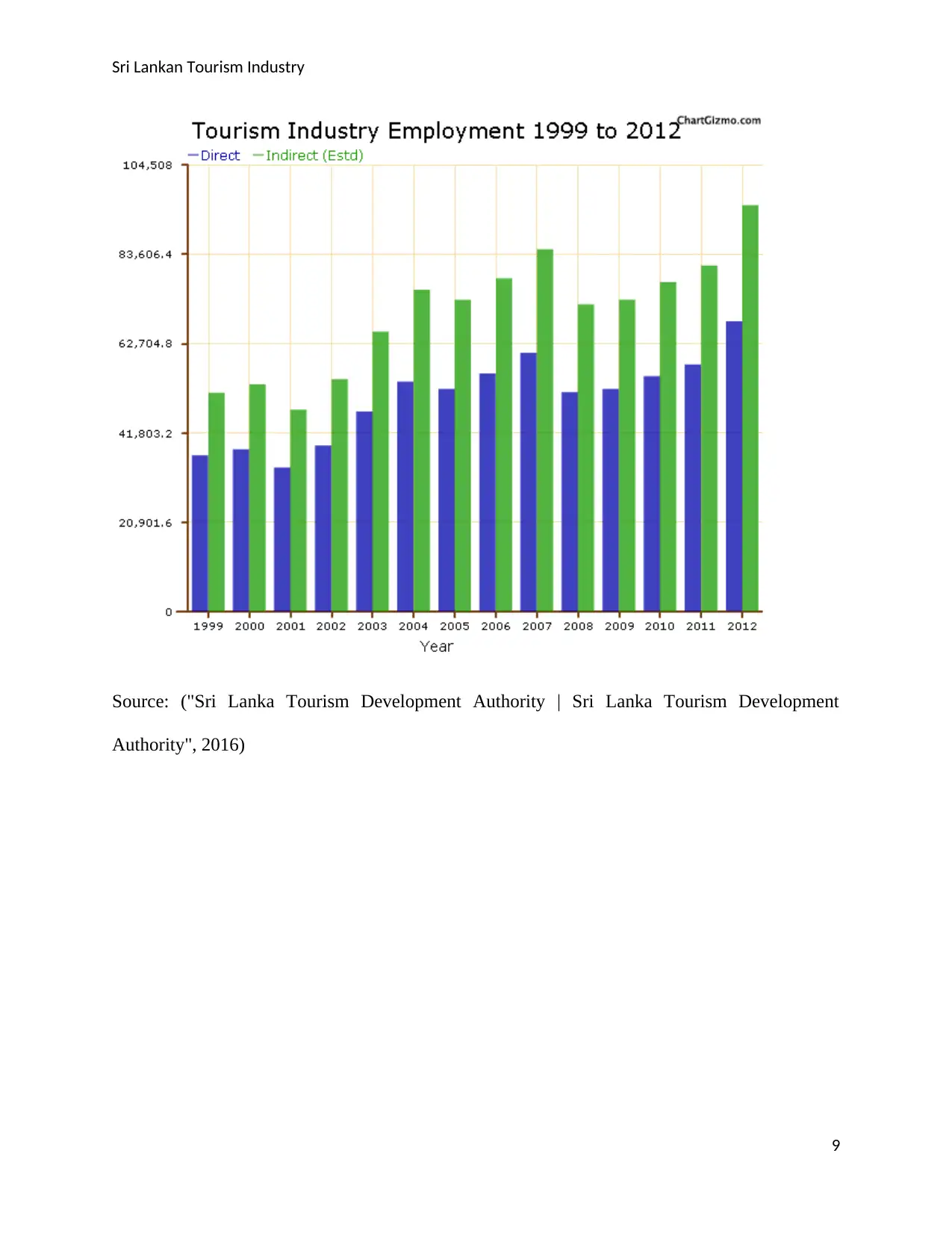
Sri Lankan Tourism Industry
Source: ("Sri Lanka Tourism Development Authority | Sri Lanka Tourism Development
Authority", 2016)
9
Source: ("Sri Lanka Tourism Development Authority | Sri Lanka Tourism Development
Authority", 2016)
9
Paraphrase This Document
Need a fresh take? Get an instant paraphrase of this document with our AI Paraphraser
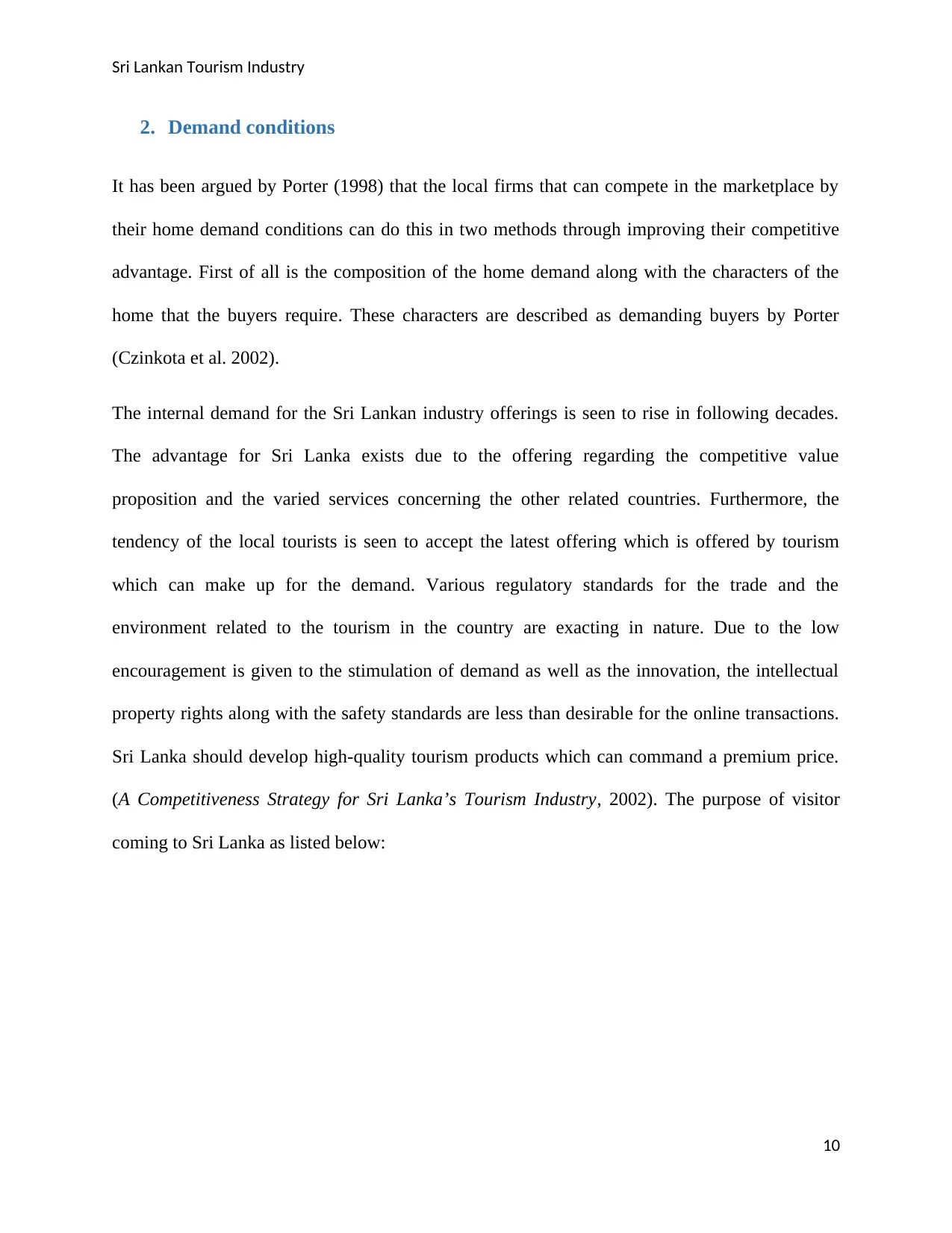
Sri Lankan Tourism Industry
2. Demand conditions
It has been argued by Porter (1998) that the local firms that can compete in the marketplace by
their home demand conditions can do this in two methods through improving their competitive
advantage. First of all is the composition of the home demand along with the characters of the
home that the buyers require. These characters are described as demanding buyers by Porter
(Czinkota et al. 2002).
The internal demand for the Sri Lankan industry offerings is seen to rise in following decades.
The advantage for Sri Lanka exists due to the offering regarding the competitive value
proposition and the varied services concerning the other related countries. Furthermore, the
tendency of the local tourists is seen to accept the latest offering which is offered by tourism
which can make up for the demand. Various regulatory standards for the trade and the
environment related to the tourism in the country are exacting in nature. Due to the low
encouragement is given to the stimulation of demand as well as the innovation, the intellectual
property rights along with the safety standards are less than desirable for the online transactions.
Sri Lanka should develop high-quality tourism products which can command a premium price.
(A Competitiveness Strategy for Sri Lanka’s Tourism Industry, 2002). The purpose of visitor
coming to Sri Lanka as listed below:
10
2. Demand conditions
It has been argued by Porter (1998) that the local firms that can compete in the marketplace by
their home demand conditions can do this in two methods through improving their competitive
advantage. First of all is the composition of the home demand along with the characters of the
home that the buyers require. These characters are described as demanding buyers by Porter
(Czinkota et al. 2002).
The internal demand for the Sri Lankan industry offerings is seen to rise in following decades.
The advantage for Sri Lanka exists due to the offering regarding the competitive value
proposition and the varied services concerning the other related countries. Furthermore, the
tendency of the local tourists is seen to accept the latest offering which is offered by tourism
which can make up for the demand. Various regulatory standards for the trade and the
environment related to the tourism in the country are exacting in nature. Due to the low
encouragement is given to the stimulation of demand as well as the innovation, the intellectual
property rights along with the safety standards are less than desirable for the online transactions.
Sri Lanka should develop high-quality tourism products which can command a premium price.
(A Competitiveness Strategy for Sri Lanka’s Tourism Industry, 2002). The purpose of visitor
coming to Sri Lanka as listed below:
10
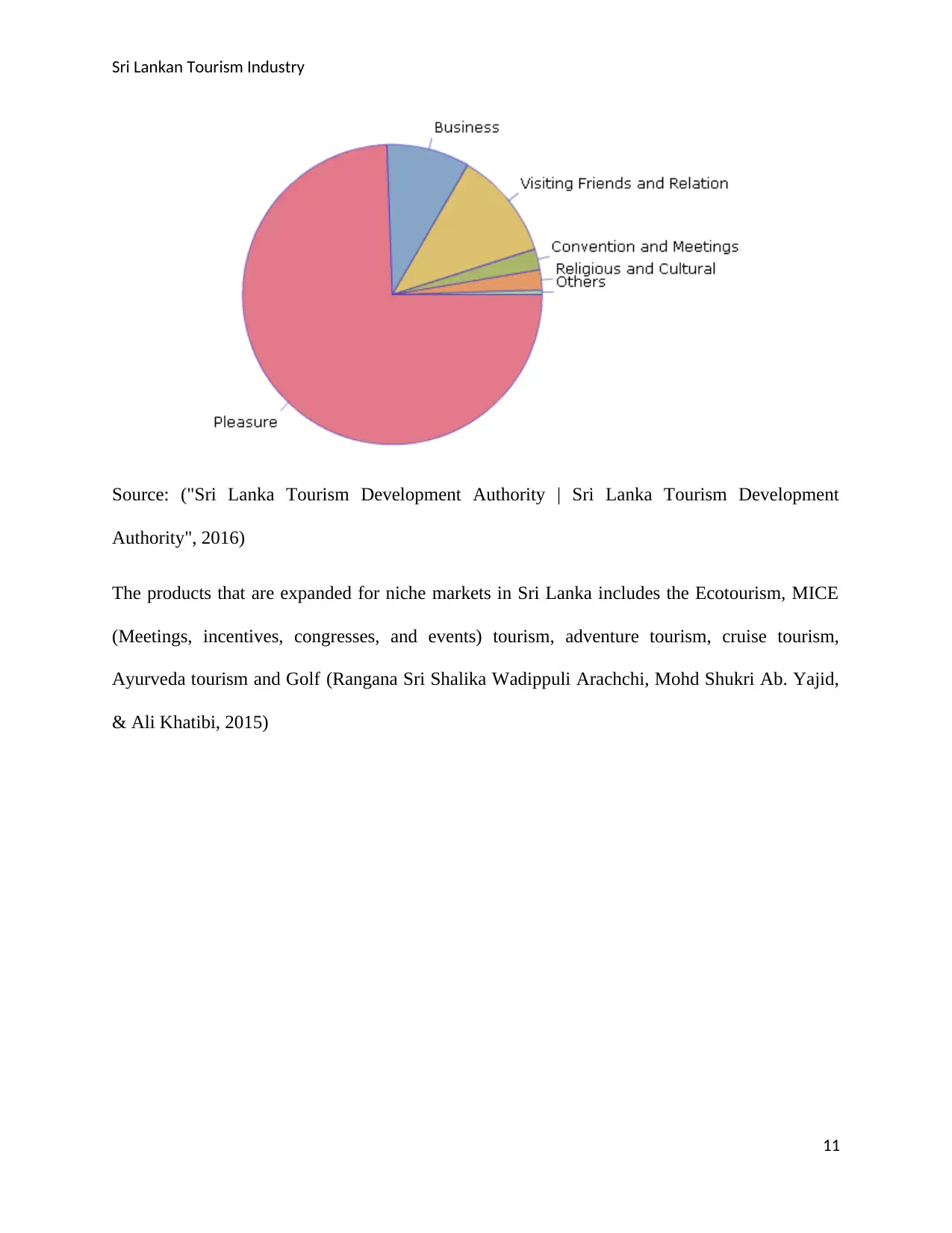
Sri Lankan Tourism Industry
Source: ("Sri Lanka Tourism Development Authority | Sri Lanka Tourism Development
Authority", 2016)
The products that are expanded for niche markets in Sri Lanka includes the Ecotourism, MICE
(Meetings, incentives, congresses, and events) tourism, adventure tourism, cruise tourism,
Ayurveda tourism and Golf (Rangana Sri Shalika Wadippuli Arachchi, Mohd Shukri Ab. Yajid,
& Ali Khatibi, 2015)
11
Source: ("Sri Lanka Tourism Development Authority | Sri Lanka Tourism Development
Authority", 2016)
The products that are expanded for niche markets in Sri Lanka includes the Ecotourism, MICE
(Meetings, incentives, congresses, and events) tourism, adventure tourism, cruise tourism,
Ayurveda tourism and Golf (Rangana Sri Shalika Wadippuli Arachchi, Mohd Shukri Ab. Yajid,
& Ali Khatibi, 2015)
11
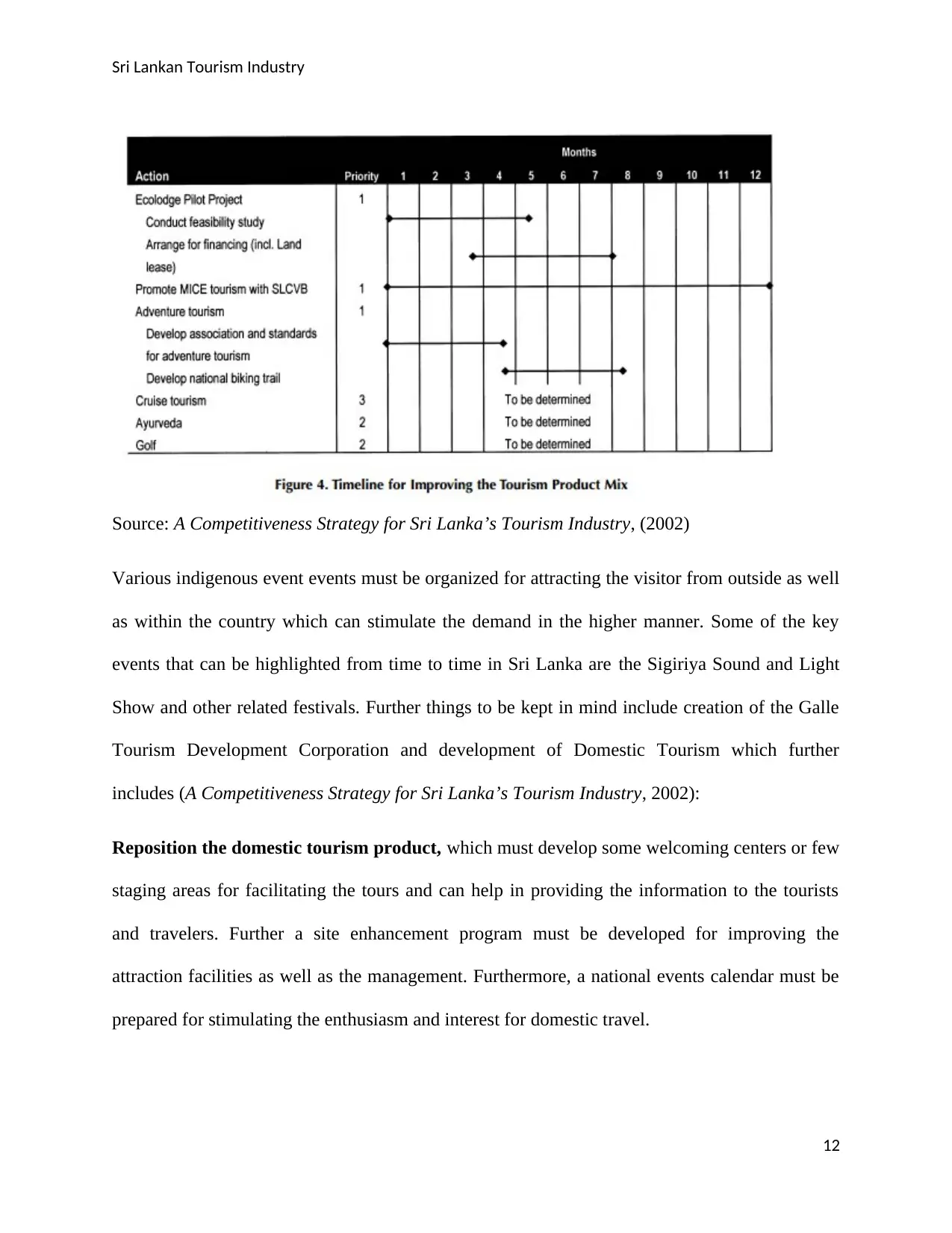
Sri Lankan Tourism Industry
Source: A Competitiveness Strategy for Sri Lanka’s Tourism Industry, (2002)
Various indigenous event events must be organized for attracting the visitor from outside as well
as within the country which can stimulate the demand in the higher manner. Some of the key
events that can be highlighted from time to time in Sri Lanka are the Sigiriya Sound and Light
Show and other related festivals. Further things to be kept in mind include creation of the Galle
Tourism Development Corporation and development of Domestic Tourism which further
includes (A Competitiveness Strategy for Sri Lanka’s Tourism Industry, 2002):
Reposition the domestic tourism product, which must develop some welcoming centers or few
staging areas for facilitating the tours and can help in providing the information to the tourists
and travelers. Further a site enhancement program must be developed for improving the
attraction facilities as well as the management. Furthermore, a national events calendar must be
prepared for stimulating the enthusiasm and interest for domestic travel.
12
Source: A Competitiveness Strategy for Sri Lanka’s Tourism Industry, (2002)
Various indigenous event events must be organized for attracting the visitor from outside as well
as within the country which can stimulate the demand in the higher manner. Some of the key
events that can be highlighted from time to time in Sri Lanka are the Sigiriya Sound and Light
Show and other related festivals. Further things to be kept in mind include creation of the Galle
Tourism Development Corporation and development of Domestic Tourism which further
includes (A Competitiveness Strategy for Sri Lanka’s Tourism Industry, 2002):
Reposition the domestic tourism product, which must develop some welcoming centers or few
staging areas for facilitating the tours and can help in providing the information to the tourists
and travelers. Further a site enhancement program must be developed for improving the
attraction facilities as well as the management. Furthermore, a national events calendar must be
prepared for stimulating the enthusiasm and interest for domestic travel.
12
Secure Best Marks with AI Grader
Need help grading? Try our AI Grader for instant feedback on your assignments.

Sri Lankan Tourism Industry
Organize a domestic tourism transport network, which can incorporate a national tourism
signage system for way finding and sites; further an approach must be built for scenic byway
designation and tour routing.
Develop a domestic travelers’ information system, which can help in incorporating a Tamil
Sri Lanka Guide along with Sinhala teaching guide and further a quality rating system for
accommodations that can help to cater the domestic traveler (Wickramasinghe, V., & Takano, S.
E., 2010).
3. Related and Supporting Industries
According to Porter, presence of the related and supporting industries which are successful
internationally is the third most important determinant of the competitive advantage. This factor
will help in creating competitive advantage in various ways which can help in providing early
and preferential access to the ongoing coordination and an integral working relationship amongst
the suppliers leading to the proximity of technical personnel and managerial along with the
cultural similarities tending for facilitating open and free informational flow (Porter 1998).
Sri Lankan Tourism Board is planning to develop Galle, which is a historic city on the South
West Coast, and combines the cultural tourism and beach attraction. This city has an intense
potential to be an international destination, the center for business meeting and yachting marina.
The place is expected to become a center for shopping, cultural excursions, dining, and
entertainment for tourist at the beach resorts. Furthermore, the place embodies the rich history of
Sri Lanka colonization by the British, Portuguese and Dutch. The Galle Fort has even earned the
World Heritage Site due to the best example of European presence in all of the Asia. (Garcin, M.
et al., 2008)
13
Organize a domestic tourism transport network, which can incorporate a national tourism
signage system for way finding and sites; further an approach must be built for scenic byway
designation and tour routing.
Develop a domestic travelers’ information system, which can help in incorporating a Tamil
Sri Lanka Guide along with Sinhala teaching guide and further a quality rating system for
accommodations that can help to cater the domestic traveler (Wickramasinghe, V., & Takano, S.
E., 2010).
3. Related and Supporting Industries
According to Porter, presence of the related and supporting industries which are successful
internationally is the third most important determinant of the competitive advantage. This factor
will help in creating competitive advantage in various ways which can help in providing early
and preferential access to the ongoing coordination and an integral working relationship amongst
the suppliers leading to the proximity of technical personnel and managerial along with the
cultural similarities tending for facilitating open and free informational flow (Porter 1998).
Sri Lankan Tourism Board is planning to develop Galle, which is a historic city on the South
West Coast, and combines the cultural tourism and beach attraction. This city has an intense
potential to be an international destination, the center for business meeting and yachting marina.
The place is expected to become a center for shopping, cultural excursions, dining, and
entertainment for tourist at the beach resorts. Furthermore, the place embodies the rich history of
Sri Lanka colonization by the British, Portuguese and Dutch. The Galle Fort has even earned the
World Heritage Site due to the best example of European presence in all of the Asia. (Garcin, M.
et al., 2008)
13
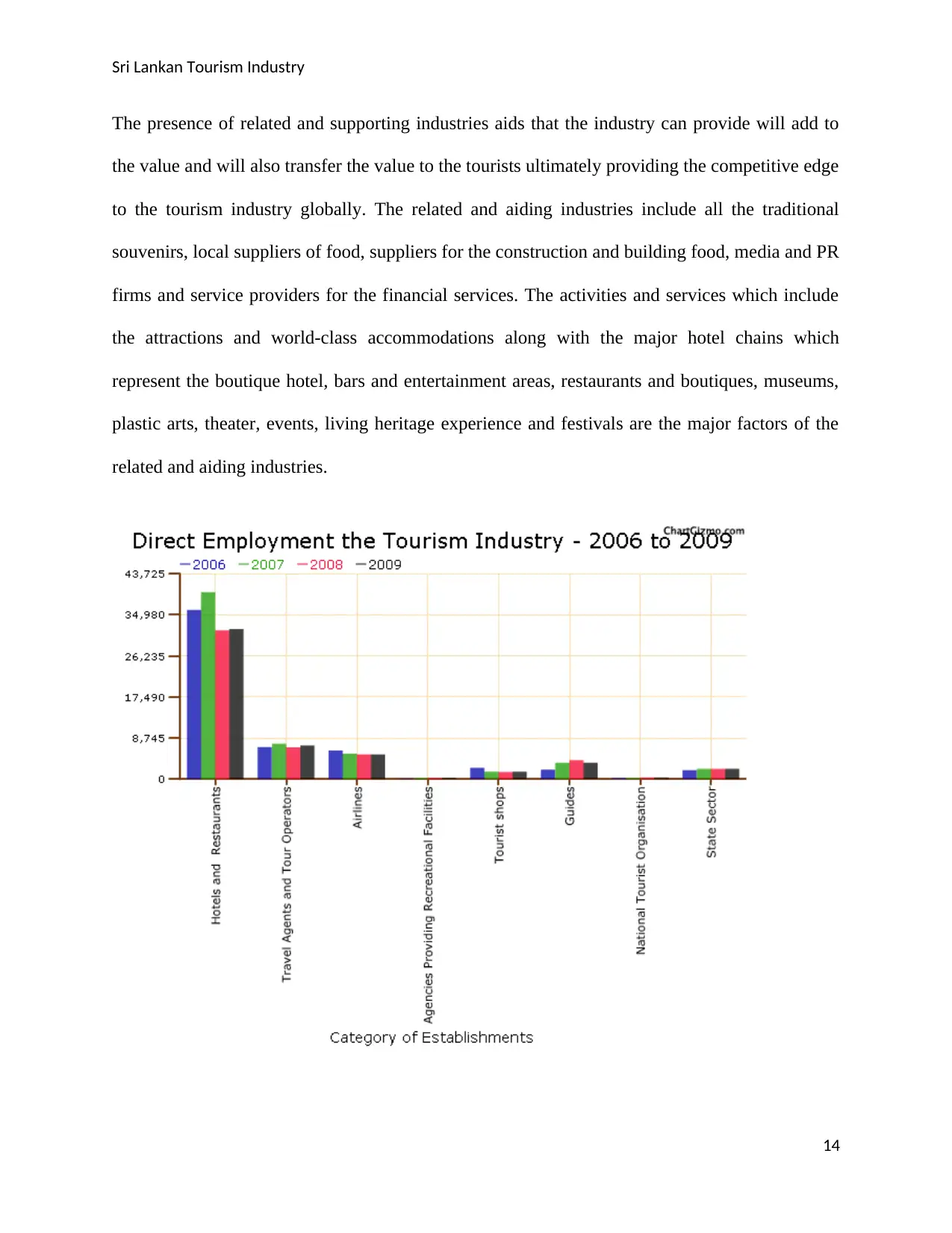
Sri Lankan Tourism Industry
The presence of related and supporting industries aids that the industry can provide will add to
the value and will also transfer the value to the tourists ultimately providing the competitive edge
to the tourism industry globally. The related and aiding industries include all the traditional
souvenirs, local suppliers of food, suppliers for the construction and building food, media and PR
firms and service providers for the financial services. The activities and services which include
the attractions and world-class accommodations along with the major hotel chains which
represent the boutique hotel, bars and entertainment areas, restaurants and boutiques, museums,
plastic arts, theater, events, living heritage experience and festivals are the major factors of the
related and aiding industries.
14
The presence of related and supporting industries aids that the industry can provide will add to
the value and will also transfer the value to the tourists ultimately providing the competitive edge
to the tourism industry globally. The related and aiding industries include all the traditional
souvenirs, local suppliers of food, suppliers for the construction and building food, media and PR
firms and service providers for the financial services. The activities and services which include
the attractions and world-class accommodations along with the major hotel chains which
represent the boutique hotel, bars and entertainment areas, restaurants and boutiques, museums,
plastic arts, theater, events, living heritage experience and festivals are the major factors of the
related and aiding industries.
14
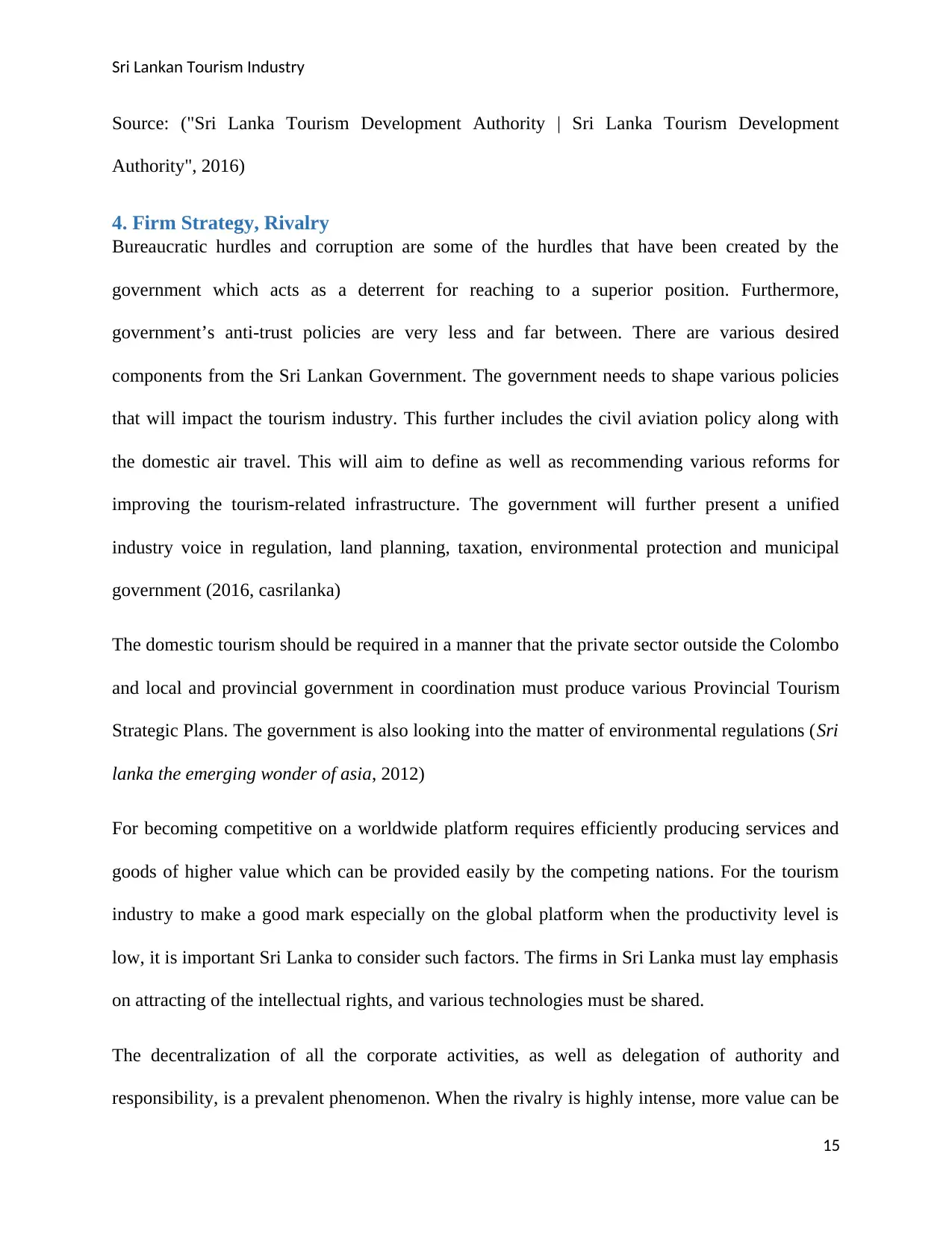
Sri Lankan Tourism Industry
Source: ("Sri Lanka Tourism Development Authority | Sri Lanka Tourism Development
Authority", 2016)
4. Firm Strategy, Rivalry
Bureaucratic hurdles and corruption are some of the hurdles that have been created by the
government which acts as a deterrent for reaching to a superior position. Furthermore,
government’s anti-trust policies are very less and far between. There are various desired
components from the Sri Lankan Government. The government needs to shape various policies
that will impact the tourism industry. This further includes the civil aviation policy along with
the domestic air travel. This will aim to define as well as recommending various reforms for
improving the tourism-related infrastructure. The government will further present a unified
industry voice in regulation, land planning, taxation, environmental protection and municipal
government (2016, casrilanka)
The domestic tourism should be required in a manner that the private sector outside the Colombo
and local and provincial government in coordination must produce various Provincial Tourism
Strategic Plans. The government is also looking into the matter of environmental regulations (Sri
lanka the emerging wonder of asia, 2012)
For becoming competitive on a worldwide platform requires efficiently producing services and
goods of higher value which can be provided easily by the competing nations. For the tourism
industry to make a good mark especially on the global platform when the productivity level is
low, it is important Sri Lanka to consider such factors. The firms in Sri Lanka must lay emphasis
on attracting of the intellectual rights, and various technologies must be shared.
The decentralization of all the corporate activities, as well as delegation of authority and
responsibility, is a prevalent phenomenon. When the rivalry is highly intense, more value can be
15
Source: ("Sri Lanka Tourism Development Authority | Sri Lanka Tourism Development
Authority", 2016)
4. Firm Strategy, Rivalry
Bureaucratic hurdles and corruption are some of the hurdles that have been created by the
government which acts as a deterrent for reaching to a superior position. Furthermore,
government’s anti-trust policies are very less and far between. There are various desired
components from the Sri Lankan Government. The government needs to shape various policies
that will impact the tourism industry. This further includes the civil aviation policy along with
the domestic air travel. This will aim to define as well as recommending various reforms for
improving the tourism-related infrastructure. The government will further present a unified
industry voice in regulation, land planning, taxation, environmental protection and municipal
government (2016, casrilanka)
The domestic tourism should be required in a manner that the private sector outside the Colombo
and local and provincial government in coordination must produce various Provincial Tourism
Strategic Plans. The government is also looking into the matter of environmental regulations (Sri
lanka the emerging wonder of asia, 2012)
For becoming competitive on a worldwide platform requires efficiently producing services and
goods of higher value which can be provided easily by the competing nations. For the tourism
industry to make a good mark especially on the global platform when the productivity level is
low, it is important Sri Lanka to consider such factors. The firms in Sri Lanka must lay emphasis
on attracting of the intellectual rights, and various technologies must be shared.
The decentralization of all the corporate activities, as well as delegation of authority and
responsibility, is a prevalent phenomenon. When the rivalry is highly intense, more value can be
15
Paraphrase This Document
Need a fresh take? Get an instant paraphrase of this document with our AI Paraphraser

Sri Lankan Tourism Industry
given to the consumers for the types of services offered. Furthermore, the labor and the employer
relationship are highly cooperative for discouraging the untoward strikes or the major hurdles so
getting the productive output. Therefore, the tourism board should pursue the competitive
strategy for stimulating productive rivalry (Sri Lanka the emerging wonder of asia, 2012).
The country has been facing high criminal activities (Police.lk.,2016). Most of the crimes have
been seen against the Westerners and the Americans like hotel room thefts, pickpocketing etc.
the cases of presence of touts is very common around the popular hotels, tourist sites and
shopping areas. High number of grave crimes were encountered in 2015 in the cities like
Colombo, Borella, cinnamon Garden districts etc. However these crimes are preventable. The
most common crimes involve robbery, stabling, kidnapping, break-ins, sexual assaults, rape,
murder etc. (osac, 2015)
5. Role of Government
It has been argued by Porter that the role of government has been one of the influencings
determining in the competitive advantage. The four determinants can be impacted negatively or
positively. Therefore the role of Sri Lankan Government can act as an influencer. The policies
and strategies adopted by the Sri Lankan Tourism Board have impacted the tourism sector both
in a positive and negative manner. The Sri Lankan Government has been considering to adopt
various policy reforms areas in the field of tourism and land planning, environment, municipal
government, taxation and incentives and various other tourism regulation.
The government should monitor the regular payment of the taxes generated from the tourism
industry however care must be taken that the business should not undermine the business. The
tourism industry will examine all the policies which are related to the municipal government
services and how the government is being funded. The government is further examining various
16
given to the consumers for the types of services offered. Furthermore, the labor and the employer
relationship are highly cooperative for discouraging the untoward strikes or the major hurdles so
getting the productive output. Therefore, the tourism board should pursue the competitive
strategy for stimulating productive rivalry (Sri Lanka the emerging wonder of asia, 2012).
The country has been facing high criminal activities (Police.lk.,2016). Most of the crimes have
been seen against the Westerners and the Americans like hotel room thefts, pickpocketing etc.
the cases of presence of touts is very common around the popular hotels, tourist sites and
shopping areas. High number of grave crimes were encountered in 2015 in the cities like
Colombo, Borella, cinnamon Garden districts etc. However these crimes are preventable. The
most common crimes involve robbery, stabling, kidnapping, break-ins, sexual assaults, rape,
murder etc. (osac, 2015)
5. Role of Government
It has been argued by Porter that the role of government has been one of the influencings
determining in the competitive advantage. The four determinants can be impacted negatively or
positively. Therefore the role of Sri Lankan Government can act as an influencer. The policies
and strategies adopted by the Sri Lankan Tourism Board have impacted the tourism sector both
in a positive and negative manner. The Sri Lankan Government has been considering to adopt
various policy reforms areas in the field of tourism and land planning, environment, municipal
government, taxation and incentives and various other tourism regulation.
The government should monitor the regular payment of the taxes generated from the tourism
industry however care must be taken that the business should not undermine the business. The
tourism industry will examine all the policies which are related to the municipal government
services and how the government is being funded. The government is further examining various
16

Sri Lankan Tourism Industry
reforms in the issues of water and sanitation, town planning and waste management (A
Competitiveness Strategy for Sri Lanka’s Tourism Industry, 2002).
Sri Lanka Tourism Board is playing a key role in influencing the competitiveness in a manner
that it affects the fair trade participation, promotion campaign, local tourism promotion, generic
promotion. Therefore it is evident that the role of government in affecting the competitive
landscape in the global tourism industry is highly imperative (Hall, C. M., Pender, L., & Sharpley,
R., 2005).
6. Role of Chance
The chance events are not directly the determinant of the competitive advantage. These include
the events which are considered to be outside of the firm, government or industry control (Ali et
al. 1997). However according to Porter, these play a significant role on the competitive
advantage. These can alter the conditions in the diamond and can have the asymmetric impact on
various nations. The major factors affecting the competitiveness include the exchange rate
movements and the slowdown in the economy. It has been seen that the Sri Lankan government
is not able to control the exchange rate directly which is determined by the demand and supply
especially existing in the foreign exchange market. It has seen that the Sri Lankan Rupee (LKR)
has depreciated as compared to the other rivals present in the tourism industry. The
competitiveness of the chance event has led to cheaper tourism package in Sri Lanka as
compared to the international markets. (Wij, I., 2011).
17
reforms in the issues of water and sanitation, town planning and waste management (A
Competitiveness Strategy for Sri Lanka’s Tourism Industry, 2002).
Sri Lanka Tourism Board is playing a key role in influencing the competitiveness in a manner
that it affects the fair trade participation, promotion campaign, local tourism promotion, generic
promotion. Therefore it is evident that the role of government in affecting the competitive
landscape in the global tourism industry is highly imperative (Hall, C. M., Pender, L., & Sharpley,
R., 2005).
6. Role of Chance
The chance events are not directly the determinant of the competitive advantage. These include
the events which are considered to be outside of the firm, government or industry control (Ali et
al. 1997). However according to Porter, these play a significant role on the competitive
advantage. These can alter the conditions in the diamond and can have the asymmetric impact on
various nations. The major factors affecting the competitiveness include the exchange rate
movements and the slowdown in the economy. It has been seen that the Sri Lankan government
is not able to control the exchange rate directly which is determined by the demand and supply
especially existing in the foreign exchange market. It has seen that the Sri Lankan Rupee (LKR)
has depreciated as compared to the other rivals present in the tourism industry. The
competitiveness of the chance event has led to cheaper tourism package in Sri Lanka as
compared to the international markets. (Wij, I., 2011).
17
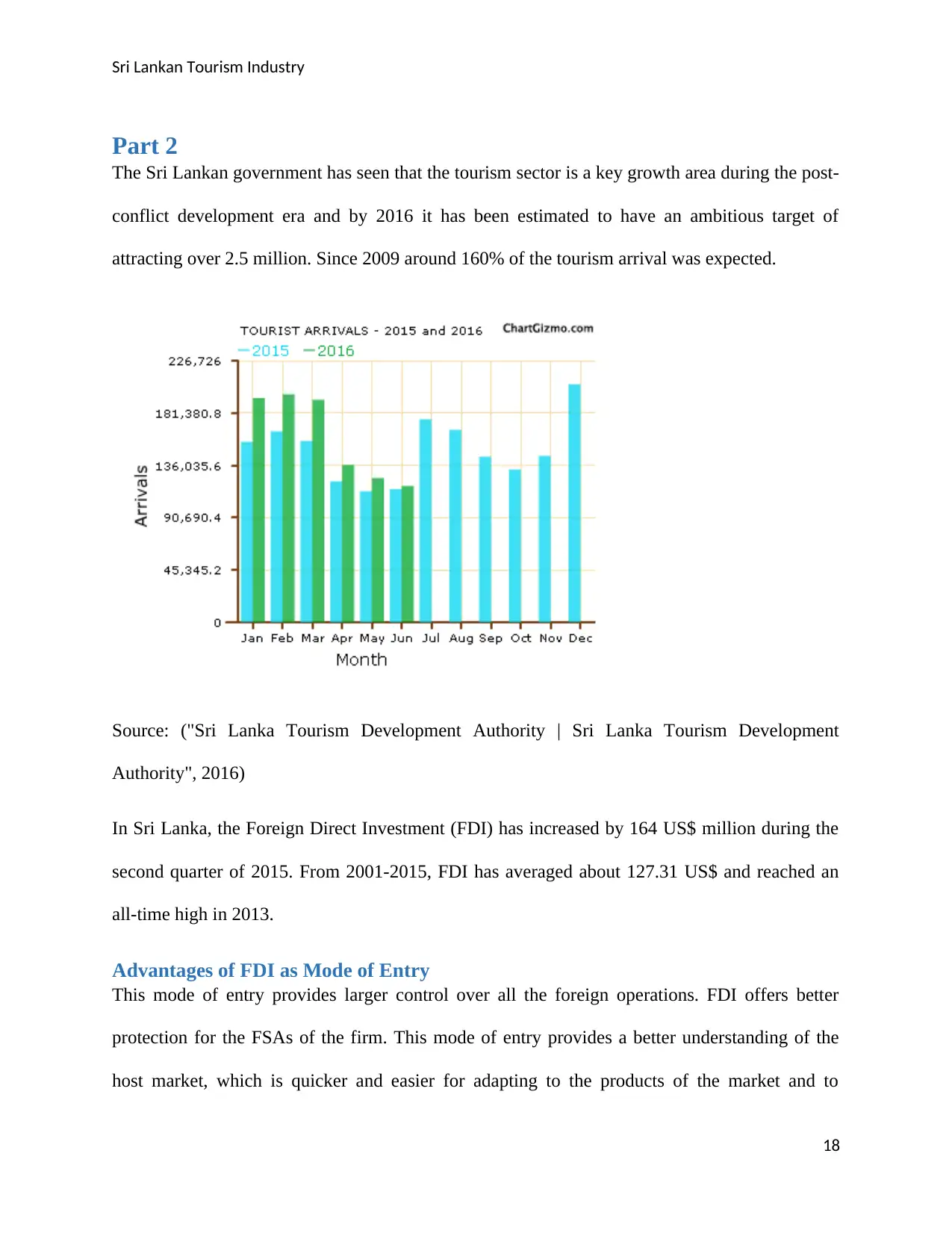
Sri Lankan Tourism Industry
Part 2
The Sri Lankan government has seen that the tourism sector is a key growth area during the post-
conflict development era and by 2016 it has been estimated to have an ambitious target of
attracting over 2.5 million. Since 2009 around 160% of the tourism arrival was expected.
Source: ("Sri Lanka Tourism Development Authority | Sri Lanka Tourism Development
Authority", 2016)
In Sri Lanka, the Foreign Direct Investment (FDI) has increased by 164 US$ million during the
second quarter of 2015. From 2001-2015, FDI has averaged about 127.31 US$ and reached an
all-time high in 2013.
Advantages of FDI as Mode of Entry
This mode of entry provides larger control over all the foreign operations. FDI offers better
protection for the FSAs of the firm. This mode of entry provides a better understanding of the
host market, which is quicker and easier for adapting to the products of the market and to
18
Part 2
The Sri Lankan government has seen that the tourism sector is a key growth area during the post-
conflict development era and by 2016 it has been estimated to have an ambitious target of
attracting over 2.5 million. Since 2009 around 160% of the tourism arrival was expected.
Source: ("Sri Lanka Tourism Development Authority | Sri Lanka Tourism Development
Authority", 2016)
In Sri Lanka, the Foreign Direct Investment (FDI) has increased by 164 US$ million during the
second quarter of 2015. From 2001-2015, FDI has averaged about 127.31 US$ and reached an
all-time high in 2013.
Advantages of FDI as Mode of Entry
This mode of entry provides larger control over all the foreign operations. FDI offers better
protection for the FSAs of the firm. This mode of entry provides a better understanding of the
host market, which is quicker and easier for adapting to the products of the market and to
18
Secure Best Marks with AI Grader
Need help grading? Try our AI Grader for instant feedback on your assignments.
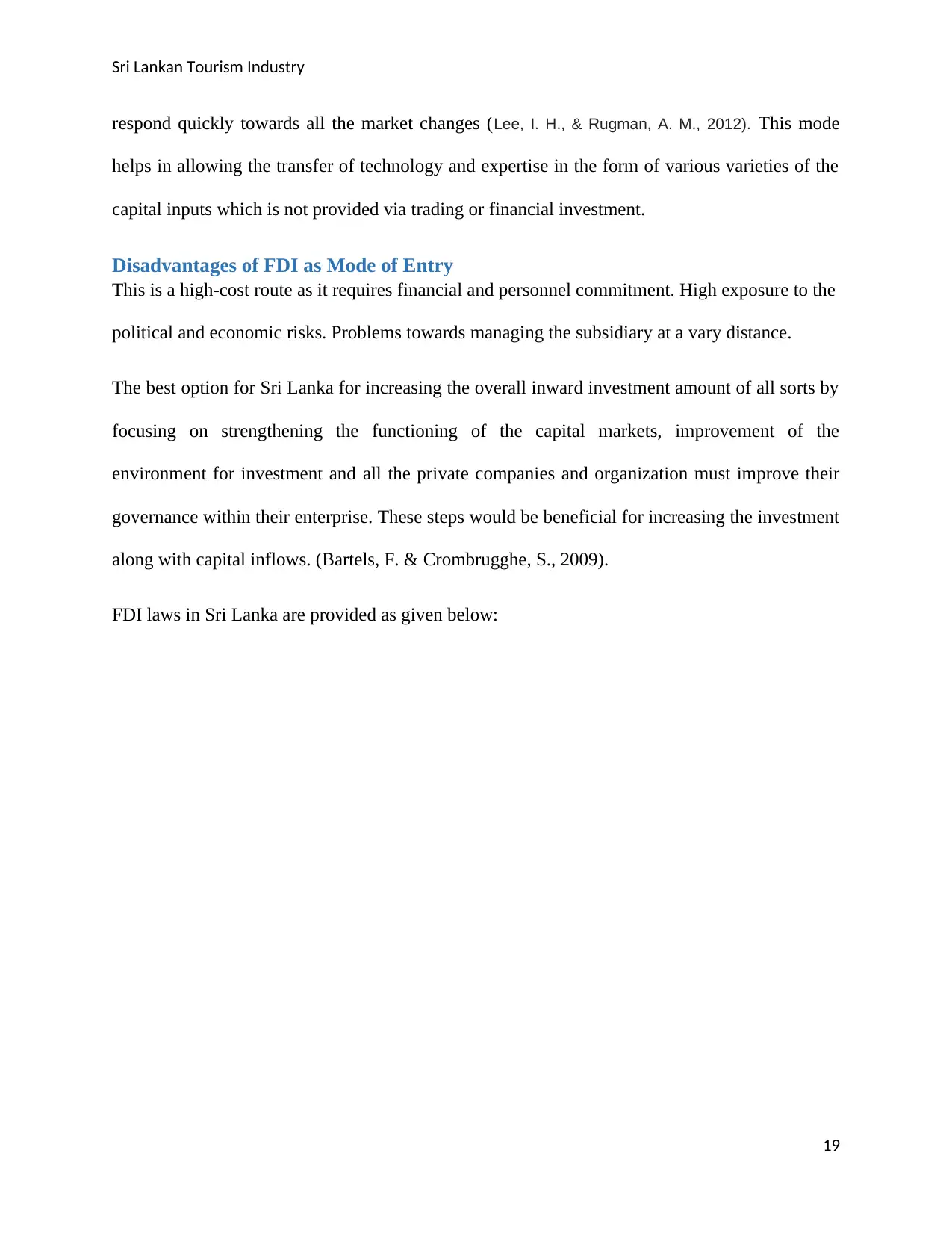
Sri Lankan Tourism Industry
respond quickly towards all the market changes (Lee, I. H., & Rugman, A. M., 2012). This mode
helps in allowing the transfer of technology and expertise in the form of various varieties of the
capital inputs which is not provided via trading or financial investment.
Disadvantages of FDI as Mode of Entry
This is a high-cost route as it requires financial and personnel commitment. High exposure to the
political and economic risks. Problems towards managing the subsidiary at a vary distance.
The best option for Sri Lanka for increasing the overall inward investment amount of all sorts by
focusing on strengthening the functioning of the capital markets, improvement of the
environment for investment and all the private companies and organization must improve their
governance within their enterprise. These steps would be beneficial for increasing the investment
along with capital inflows. (Bartels, F. & Crombrugghe, S., 2009).
FDI laws in Sri Lanka are provided as given below:
19
respond quickly towards all the market changes (Lee, I. H., & Rugman, A. M., 2012). This mode
helps in allowing the transfer of technology and expertise in the form of various varieties of the
capital inputs which is not provided via trading or financial investment.
Disadvantages of FDI as Mode of Entry
This is a high-cost route as it requires financial and personnel commitment. High exposure to the
political and economic risks. Problems towards managing the subsidiary at a vary distance.
The best option for Sri Lanka for increasing the overall inward investment amount of all sorts by
focusing on strengthening the functioning of the capital markets, improvement of the
environment for investment and all the private companies and organization must improve their
governance within their enterprise. These steps would be beneficial for increasing the investment
along with capital inflows. (Bartels, F. & Crombrugghe, S., 2009).
FDI laws in Sri Lanka are provided as given below:
19
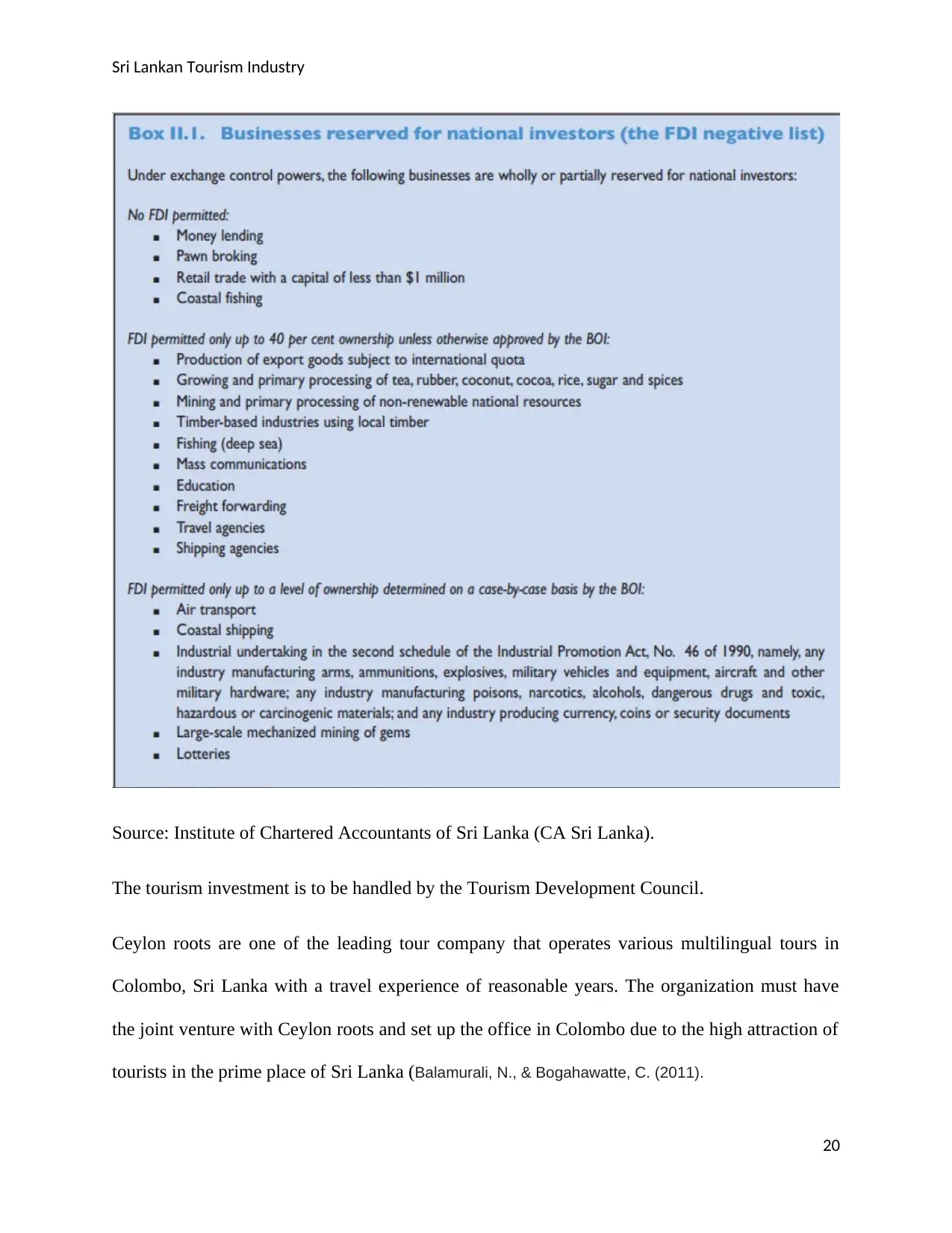
Sri Lankan Tourism Industry
Source: Institute of Chartered Accountants of Sri Lanka (CA Sri Lanka).
The tourism investment is to be handled by the Tourism Development Council.
Ceylon roots are one of the leading tour company that operates various multilingual tours in
Colombo, Sri Lanka with a travel experience of reasonable years. The organization must have
the joint venture with Ceylon roots and set up the office in Colombo due to the high attraction of
tourists in the prime place of Sri Lanka (Balamurali, N., & Bogahawatte, C. (2011).
20
Source: Institute of Chartered Accountants of Sri Lanka (CA Sri Lanka).
The tourism investment is to be handled by the Tourism Development Council.
Ceylon roots are one of the leading tour company that operates various multilingual tours in
Colombo, Sri Lanka with a travel experience of reasonable years. The organization must have
the joint venture with Ceylon roots and set up the office in Colombo due to the high attraction of
tourists in the prime place of Sri Lanka (Balamurali, N., & Bogahawatte, C. (2011).
20
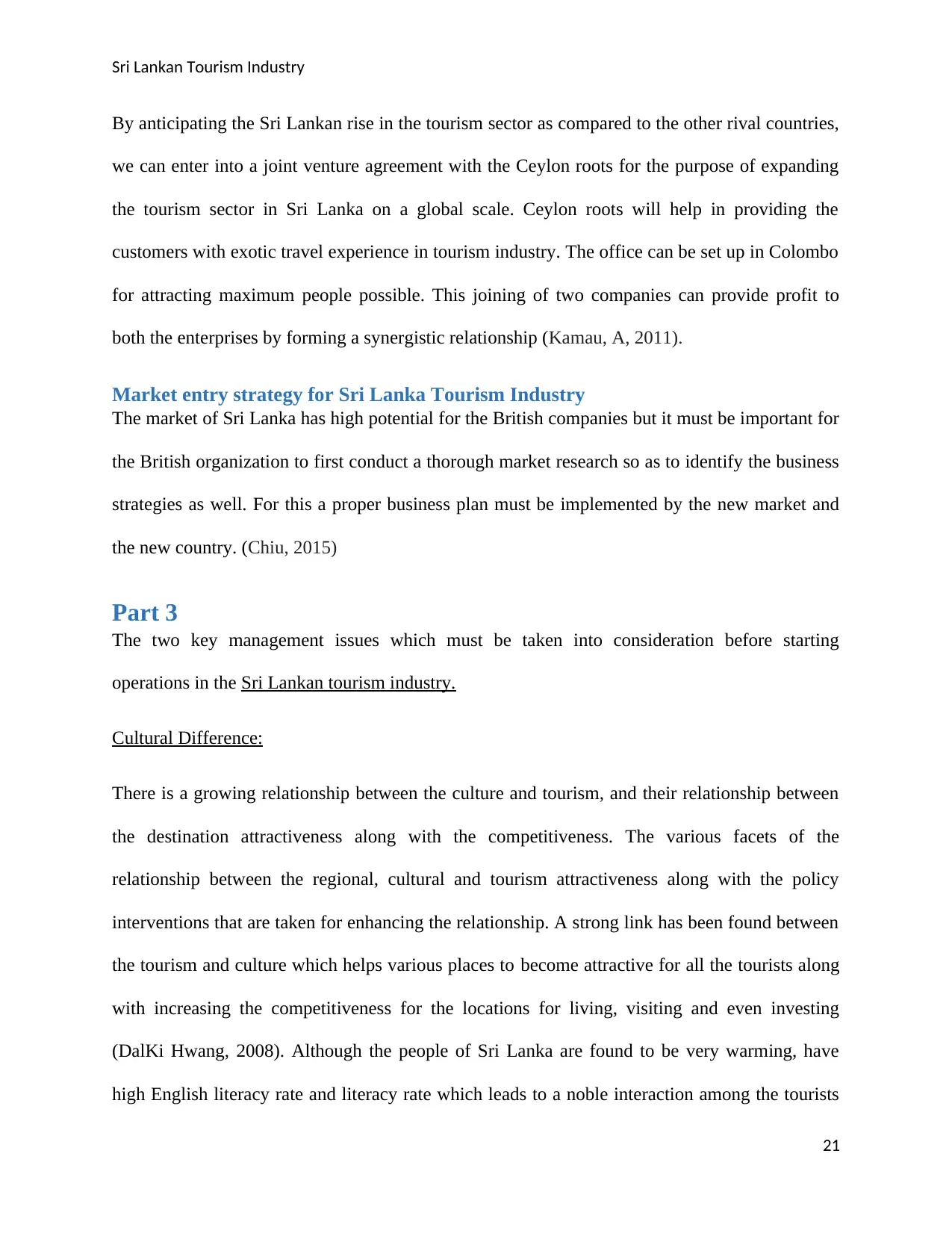
Sri Lankan Tourism Industry
By anticipating the Sri Lankan rise in the tourism sector as compared to the other rival countries,
we can enter into a joint venture agreement with the Ceylon roots for the purpose of expanding
the tourism sector in Sri Lanka on a global scale. Ceylon roots will help in providing the
customers with exotic travel experience in tourism industry. The office can be set up in Colombo
for attracting maximum people possible. This joining of two companies can provide profit to
both the enterprises by forming a synergistic relationship (Kamau, A, 2011).
Market entry strategy for Sri Lanka Tourism Industry
The market of Sri Lanka has high potential for the British companies but it must be important for
the British organization to first conduct a thorough market research so as to identify the business
strategies as well. For this a proper business plan must be implemented by the new market and
the new country. (Chiu, 2015)
Part 3
The two key management issues which must be taken into consideration before starting
operations in the Sri Lankan tourism industry.
Cultural Difference:
There is a growing relationship between the culture and tourism, and their relationship between
the destination attractiveness along with the competitiveness. The various facets of the
relationship between the regional, cultural and tourism attractiveness along with the policy
interventions that are taken for enhancing the relationship. A strong link has been found between
the tourism and culture which helps various places to become attractive for all the tourists along
with increasing the competitiveness for the locations for living, visiting and even investing
(DalKi Hwang, 2008). Although the people of Sri Lanka are found to be very warming, have
high English literacy rate and literacy rate which leads to a noble interaction among the tourists
21
By anticipating the Sri Lankan rise in the tourism sector as compared to the other rival countries,
we can enter into a joint venture agreement with the Ceylon roots for the purpose of expanding
the tourism sector in Sri Lanka on a global scale. Ceylon roots will help in providing the
customers with exotic travel experience in tourism industry. The office can be set up in Colombo
for attracting maximum people possible. This joining of two companies can provide profit to
both the enterprises by forming a synergistic relationship (Kamau, A, 2011).
Market entry strategy for Sri Lanka Tourism Industry
The market of Sri Lanka has high potential for the British companies but it must be important for
the British organization to first conduct a thorough market research so as to identify the business
strategies as well. For this a proper business plan must be implemented by the new market and
the new country. (Chiu, 2015)
Part 3
The two key management issues which must be taken into consideration before starting
operations in the Sri Lankan tourism industry.
Cultural Difference:
There is a growing relationship between the culture and tourism, and their relationship between
the destination attractiveness along with the competitiveness. The various facets of the
relationship between the regional, cultural and tourism attractiveness along with the policy
interventions that are taken for enhancing the relationship. A strong link has been found between
the tourism and culture which helps various places to become attractive for all the tourists along
with increasing the competitiveness for the locations for living, visiting and even investing
(DalKi Hwang, 2008). Although the people of Sri Lanka are found to be very warming, have
high English literacy rate and literacy rate which leads to a noble interaction among the tourists
21
Paraphrase This Document
Need a fresh take? Get an instant paraphrase of this document with our AI Paraphraser
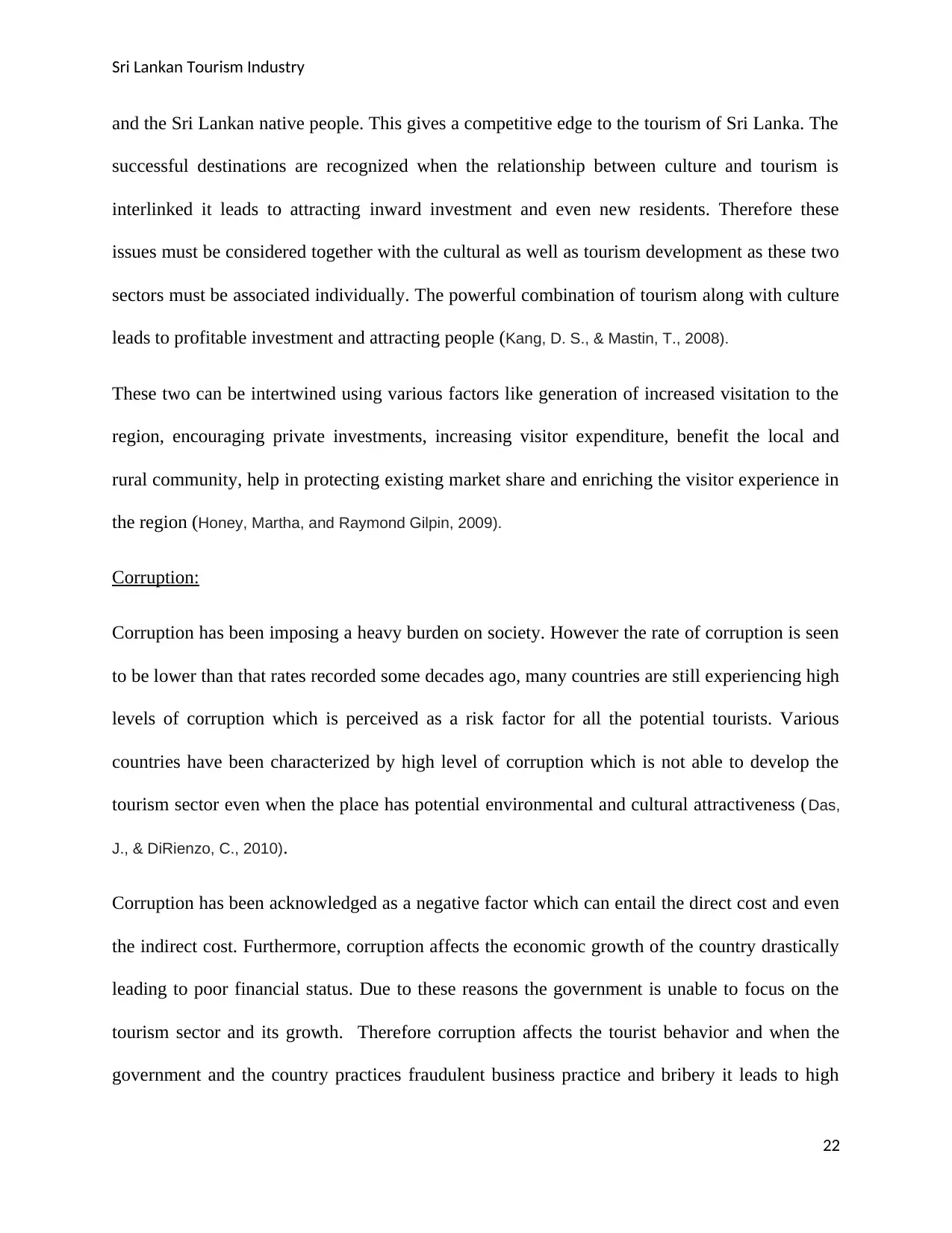
Sri Lankan Tourism Industry
and the Sri Lankan native people. This gives a competitive edge to the tourism of Sri Lanka. The
successful destinations are recognized when the relationship between culture and tourism is
interlinked it leads to attracting inward investment and even new residents. Therefore these
issues must be considered together with the cultural as well as tourism development as these two
sectors must be associated individually. The powerful combination of tourism along with culture
leads to profitable investment and attracting people (Kang, D. S., & Mastin, T., 2008).
These two can be intertwined using various factors like generation of increased visitation to the
region, encouraging private investments, increasing visitor expenditure, benefit the local and
rural community, help in protecting existing market share and enriching the visitor experience in
the region (Honey, Martha, and Raymond Gilpin, 2009).
Corruption:
Corruption has been imposing a heavy burden on society. However the rate of corruption is seen
to be lower than that rates recorded some decades ago, many countries are still experiencing high
levels of corruption which is perceived as a risk factor for all the potential tourists. Various
countries have been characterized by high level of corruption which is not able to develop the
tourism sector even when the place has potential environmental and cultural attractiveness (Das,
J., & DiRienzo, C., 2010).
Corruption has been acknowledged as a negative factor which can entail the direct cost and even
the indirect cost. Furthermore, corruption affects the economic growth of the country drastically
leading to poor financial status. Due to these reasons the government is unable to focus on the
tourism sector and its growth. Therefore corruption affects the tourist behavior and when the
government and the country practices fraudulent business practice and bribery it leads to high
22
and the Sri Lankan native people. This gives a competitive edge to the tourism of Sri Lanka. The
successful destinations are recognized when the relationship between culture and tourism is
interlinked it leads to attracting inward investment and even new residents. Therefore these
issues must be considered together with the cultural as well as tourism development as these two
sectors must be associated individually. The powerful combination of tourism along with culture
leads to profitable investment and attracting people (Kang, D. S., & Mastin, T., 2008).
These two can be intertwined using various factors like generation of increased visitation to the
region, encouraging private investments, increasing visitor expenditure, benefit the local and
rural community, help in protecting existing market share and enriching the visitor experience in
the region (Honey, Martha, and Raymond Gilpin, 2009).
Corruption:
Corruption has been imposing a heavy burden on society. However the rate of corruption is seen
to be lower than that rates recorded some decades ago, many countries are still experiencing high
levels of corruption which is perceived as a risk factor for all the potential tourists. Various
countries have been characterized by high level of corruption which is not able to develop the
tourism sector even when the place has potential environmental and cultural attractiveness (Das,
J., & DiRienzo, C., 2010).
Corruption has been acknowledged as a negative factor which can entail the direct cost and even
the indirect cost. Furthermore, corruption affects the economic growth of the country drastically
leading to poor financial status. Due to these reasons the government is unable to focus on the
tourism sector and its growth. Therefore corruption affects the tourist behavior and when the
government and the country practices fraudulent business practice and bribery it leads to high
22
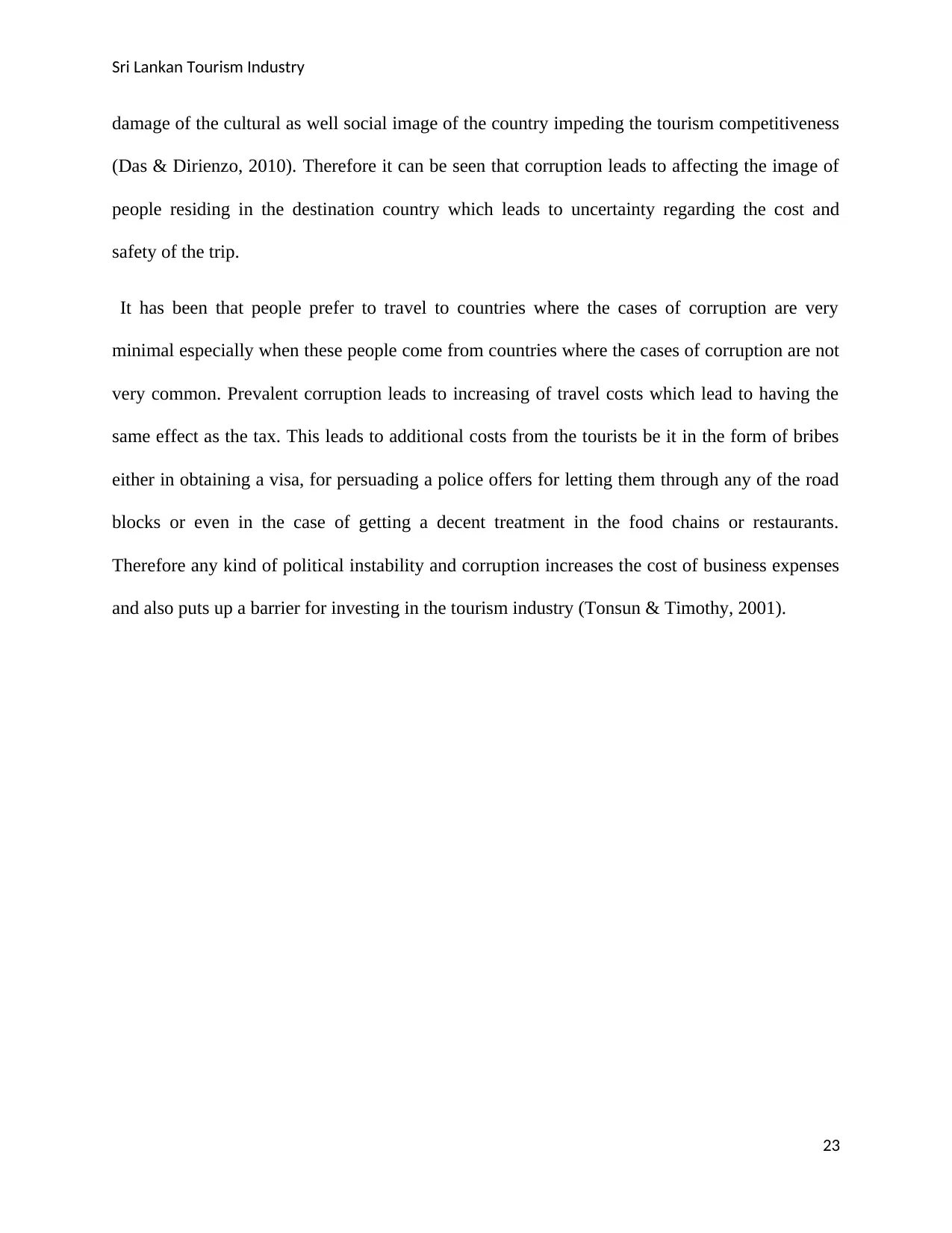
Sri Lankan Tourism Industry
damage of the cultural as well social image of the country impeding the tourism competitiveness
(Das & Dirienzo, 2010). Therefore it can be seen that corruption leads to affecting the image of
people residing in the destination country which leads to uncertainty regarding the cost and
safety of the trip.
It has been that people prefer to travel to countries where the cases of corruption are very
minimal especially when these people come from countries where the cases of corruption are not
very common. Prevalent corruption leads to increasing of travel costs which lead to having the
same effect as the tax. This leads to additional costs from the tourists be it in the form of bribes
either in obtaining a visa, for persuading a police offers for letting them through any of the road
blocks or even in the case of getting a decent treatment in the food chains or restaurants.
Therefore any kind of political instability and corruption increases the cost of business expenses
and also puts up a barrier for investing in the tourism industry (Tonsun & Timothy, 2001).
23
damage of the cultural as well social image of the country impeding the tourism competitiveness
(Das & Dirienzo, 2010). Therefore it can be seen that corruption leads to affecting the image of
people residing in the destination country which leads to uncertainty regarding the cost and
safety of the trip.
It has been that people prefer to travel to countries where the cases of corruption are very
minimal especially when these people come from countries where the cases of corruption are not
very common. Prevalent corruption leads to increasing of travel costs which lead to having the
same effect as the tax. This leads to additional costs from the tourists be it in the form of bribes
either in obtaining a visa, for persuading a police offers for letting them through any of the road
blocks or even in the case of getting a decent treatment in the food chains or restaurants.
Therefore any kind of political instability and corruption increases the cost of business expenses
and also puts up a barrier for investing in the tourism industry (Tonsun & Timothy, 2001).
23

Sri Lankan Tourism Industry
References
1. (2016). https://www.casrilanka.com. Retrieved 22 July 2016, from
https://www.casrilanka.com/casl/index.php?option=com_content&id=845:boi-laws-and-
regulations-comes-under-focus-at-ca-sri-lanka-seminar&catid=50:general&Itemid=156
2. A Competitiveness Strategy for Sri Lanka’s Tourism Industry. (2002) (1st ed.). Colombo.
Retrieved from http://pdf.usaid.gov/pdf_docs/Pnadt761.pdf
3. Ali, R, Y A Choudhry, and D W Lister. 1997. "Sri Lankan Tea Industry: Succeeding in
the Global Market." World Bank Discussion Paper No 368. Washington D C: The World
Bank.
4. An analysis of the issues and prospects facing SriLankan Airlines and its embedded
partnership with Sri Lankan tourism. (2015). Tourism Economics.
5. Balamurali, N., & Bogahawatte, C. (2011). Foreign direct investment and economic
growth in Sri Lanka. Sri Lankan Journal of Agricultural Economics,6(1).
6. Bartels, F. & Crombrugghe, S. (2009). FDI policy instruments. Vienna: United Nations
Industrial Development Organization.
7. Police.lk. (2016). Crime Trends. [online] Available at:
http://www.police.lk/index.php/crime-trends [Accessed 12 Aug. 2016].
8. osac. (2015). Sri Lanka 2015 Crime and Safety Report. [online] Available at:
https://www.osac.gov/pages/ContentReportDetails.aspx?cid=17573 [Accessed 12 Aug.
2016].
9. Chapman, C. (2005). The Asian Tsunami in Sri Lanka—a personal experience. The
Leading Edge, 24(2), 124-125.
24
References
1. (2016). https://www.casrilanka.com. Retrieved 22 July 2016, from
https://www.casrilanka.com/casl/index.php?option=com_content&id=845:boi-laws-and-
regulations-comes-under-focus-at-ca-sri-lanka-seminar&catid=50:general&Itemid=156
2. A Competitiveness Strategy for Sri Lanka’s Tourism Industry. (2002) (1st ed.). Colombo.
Retrieved from http://pdf.usaid.gov/pdf_docs/Pnadt761.pdf
3. Ali, R, Y A Choudhry, and D W Lister. 1997. "Sri Lankan Tea Industry: Succeeding in
the Global Market." World Bank Discussion Paper No 368. Washington D C: The World
Bank.
4. An analysis of the issues and prospects facing SriLankan Airlines and its embedded
partnership with Sri Lankan tourism. (2015). Tourism Economics.
5. Balamurali, N., & Bogahawatte, C. (2011). Foreign direct investment and economic
growth in Sri Lanka. Sri Lankan Journal of Agricultural Economics,6(1).
6. Bartels, F. & Crombrugghe, S. (2009). FDI policy instruments. Vienna: United Nations
Industrial Development Organization.
7. Police.lk. (2016). Crime Trends. [online] Available at:
http://www.police.lk/index.php/crime-trends [Accessed 12 Aug. 2016].
8. osac. (2015). Sri Lanka 2015 Crime and Safety Report. [online] Available at:
https://www.osac.gov/pages/ContentReportDetails.aspx?cid=17573 [Accessed 12 Aug.
2016].
9. Chapman, C. (2005). The Asian Tsunami in Sri Lanka—a personal experience. The
Leading Edge, 24(2), 124-125.
24
Secure Best Marks with AI Grader
Need help grading? Try our AI Grader for instant feedback on your assignments.

Sri Lankan Tourism Industry
10. DalKi Hwang,. (2008). The Case Study of the Relationship between Culture and Tourism
in Yufuin. Journal Of The Society Of Japanese Language And Literature, Japanology,
null(40), 357-378.
11. Das, J., & DiRienzo, C. (2010). Tourism competitiveness and corruption: A cross-
country analysis. Tourism economics, 16(3), 477-492.
12. Garcin, M., Desprats, J. F., Fontaine, M., Pedreros, R., Attanayake, N., Fernando, S., ... &
Poisson, B. (2008). Integrated approach for coastal hazards and risks in Sri
Lanka. Natural Hazards and Earth System Sciences, (8), 577-586.
13. H.M.T.S, H. & A., R. (2011). Labour Market Prospects for Business Graduates in
SriLanka. International Journal Of Social Science And Humanity, 26-30.
14. Hall, C. M., Pender, L., & Sharpley, R. (2005). The role of government in the
management of tourism: the public sector and tourism policies. The management of
tourism, 217-231.
15. Honey, Martha, and Raymond Gilpin. Tourism in the developing world: Promoting
peace and reducing poverty. Vol. 233. United States Institute of Peace, 2009.
16. Kamau, A. (2011). Market entry strategy.
17. Kang, D. S., & Mastin, T. (2008). How cultural difference affects international tourism
public relations websites: A comparative analysis using Hofstede's cultural
dimensions. Public relations review, 34(1), 54-56.
18. Lee, I. H., & Rugman, A. M. (2012). Firm-specific advantages, inward FDI origins, and
performance of multinational enterprises. Journal of International Management, 18(2),
132-146.
19. Porter, M. (1998). The competitive advantage of nations. New York: Free Press.
25
10. DalKi Hwang,. (2008). The Case Study of the Relationship between Culture and Tourism
in Yufuin. Journal Of The Society Of Japanese Language And Literature, Japanology,
null(40), 357-378.
11. Das, J., & DiRienzo, C. (2010). Tourism competitiveness and corruption: A cross-
country analysis. Tourism economics, 16(3), 477-492.
12. Garcin, M., Desprats, J. F., Fontaine, M., Pedreros, R., Attanayake, N., Fernando, S., ... &
Poisson, B. (2008). Integrated approach for coastal hazards and risks in Sri
Lanka. Natural Hazards and Earth System Sciences, (8), 577-586.
13. H.M.T.S, H. & A., R. (2011). Labour Market Prospects for Business Graduates in
SriLanka. International Journal Of Social Science And Humanity, 26-30.
14. Hall, C. M., Pender, L., & Sharpley, R. (2005). The role of government in the
management of tourism: the public sector and tourism policies. The management of
tourism, 217-231.
15. Honey, Martha, and Raymond Gilpin. Tourism in the developing world: Promoting
peace and reducing poverty. Vol. 233. United States Institute of Peace, 2009.
16. Kamau, A. (2011). Market entry strategy.
17. Kang, D. S., & Mastin, T. (2008). How cultural difference affects international tourism
public relations websites: A comparative analysis using Hofstede's cultural
dimensions. Public relations review, 34(1), 54-56.
18. Lee, I. H., & Rugman, A. M. (2012). Firm-specific advantages, inward FDI origins, and
performance of multinational enterprises. Journal of International Management, 18(2),
132-146.
19. Porter, M. (1998). The competitive advantage of nations. New York: Free Press.
25
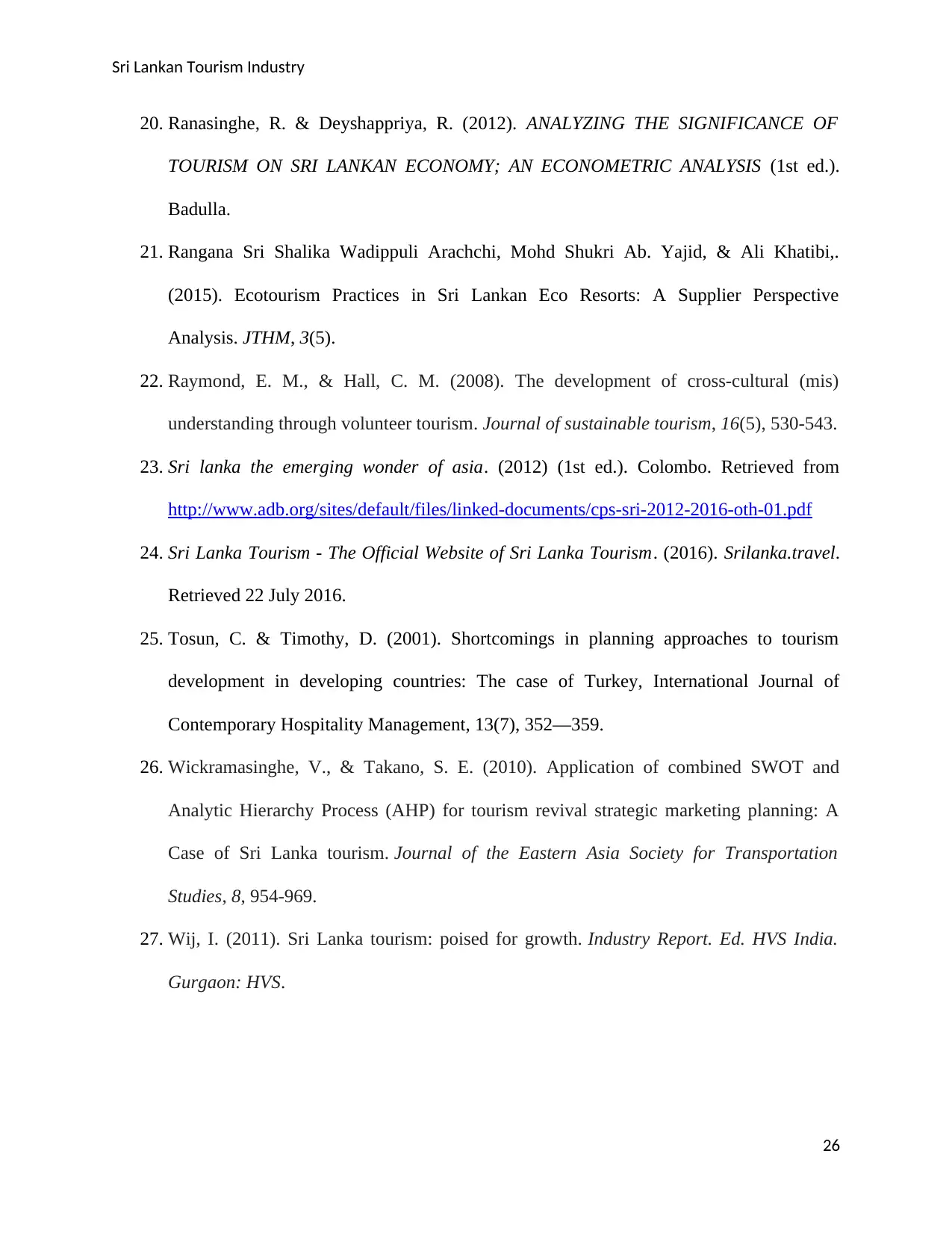
Sri Lankan Tourism Industry
20. Ranasinghe, R. & Deyshappriya, R. (2012). ANALYZING THE SIGNIFICANCE OF
TOURISM ON SRI LANKAN ECONOMY; AN ECONOMETRIC ANALYSIS (1st ed.).
Badulla.
21. Rangana Sri Shalika Wadippuli Arachchi, Mohd Shukri Ab. Yajid, & Ali Khatibi,.
(2015). Ecotourism Practices in Sri Lankan Eco Resorts: A Supplier Perspective
Analysis. JTHM, 3(5).
22. Raymond, E. M., & Hall, C. M. (2008). The development of cross-cultural (mis)
understanding through volunteer tourism. Journal of sustainable tourism, 16(5), 530-543.
23. Sri lanka the emerging wonder of asia. (2012) (1st ed.). Colombo. Retrieved from
http://www.adb.org/sites/default/files/linked-documents/cps-sri-2012-2016-oth-01.pdf
24. Sri Lanka Tourism - The Official Website of Sri Lanka Tourism. (2016). Srilanka.travel.
Retrieved 22 July 2016.
25. Tosun, C. & Timothy, D. (2001). Shortcomings in planning approaches to tourism
development in developing countries: The case of Turkey, International Journal of
Contemporary Hospitality Management, 13(7), 352—359.
26. Wickramasinghe, V., & Takano, S. E. (2010). Application of combined SWOT and
Analytic Hierarchy Process (AHP) for tourism revival strategic marketing planning: A
Case of Sri Lanka tourism. Journal of the Eastern Asia Society for Transportation
Studies, 8, 954-969.
27. Wij, I. (2011). Sri Lanka tourism: poised for growth. Industry Report. Ed. HVS India.
Gurgaon: HVS.
26
20. Ranasinghe, R. & Deyshappriya, R. (2012). ANALYZING THE SIGNIFICANCE OF
TOURISM ON SRI LANKAN ECONOMY; AN ECONOMETRIC ANALYSIS (1st ed.).
Badulla.
21. Rangana Sri Shalika Wadippuli Arachchi, Mohd Shukri Ab. Yajid, & Ali Khatibi,.
(2015). Ecotourism Practices in Sri Lankan Eco Resorts: A Supplier Perspective
Analysis. JTHM, 3(5).
22. Raymond, E. M., & Hall, C. M. (2008). The development of cross-cultural (mis)
understanding through volunteer tourism. Journal of sustainable tourism, 16(5), 530-543.
23. Sri lanka the emerging wonder of asia. (2012) (1st ed.). Colombo. Retrieved from
http://www.adb.org/sites/default/files/linked-documents/cps-sri-2012-2016-oth-01.pdf
24. Sri Lanka Tourism - The Official Website of Sri Lanka Tourism. (2016). Srilanka.travel.
Retrieved 22 July 2016.
25. Tosun, C. & Timothy, D. (2001). Shortcomings in planning approaches to tourism
development in developing countries: The case of Turkey, International Journal of
Contemporary Hospitality Management, 13(7), 352—359.
26. Wickramasinghe, V., & Takano, S. E. (2010). Application of combined SWOT and
Analytic Hierarchy Process (AHP) for tourism revival strategic marketing planning: A
Case of Sri Lanka tourism. Journal of the Eastern Asia Society for Transportation
Studies, 8, 954-969.
27. Wij, I. (2011). Sri Lanka tourism: poised for growth. Industry Report. Ed. HVS India.
Gurgaon: HVS.
26
1 out of 27
Related Documents
Your All-in-One AI-Powered Toolkit for Academic Success.
+13062052269
info@desklib.com
Available 24*7 on WhatsApp / Email
![[object Object]](/_next/static/media/star-bottom.7253800d.svg)
Unlock your academic potential
© 2024 | Zucol Services PVT LTD | All rights reserved.





